Travels with Dick and Karen
Florida, Part 3
The Everglades
(yellow line on map) |
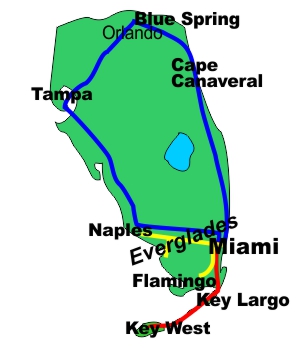 |
| First stop was the famous fruit and vegetable stand just outside the Everglades National Park. |
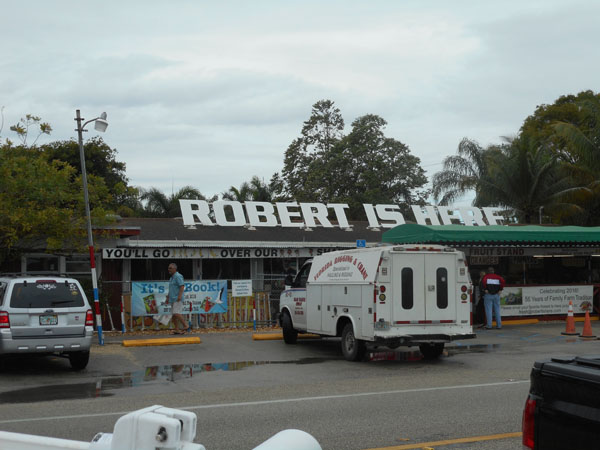 |
Then south to the park's Flamingo campground at the very southern tip of Florida |
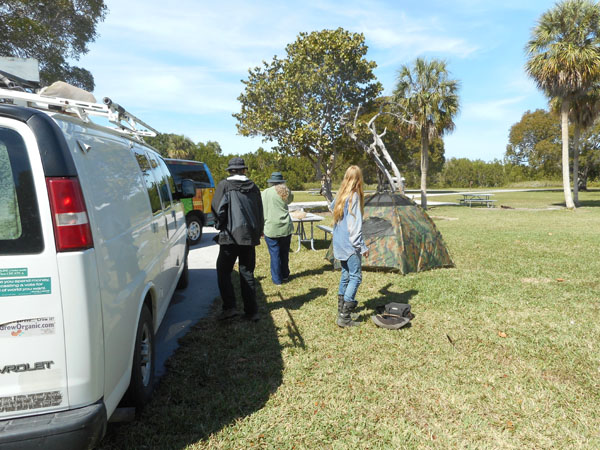 |
Where vultures instead of jays patrolled the grounds |
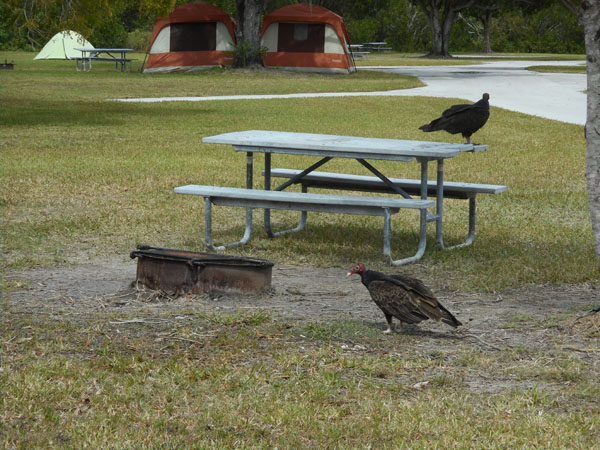 |
| New Zealand has similar signs about Kia parrots |
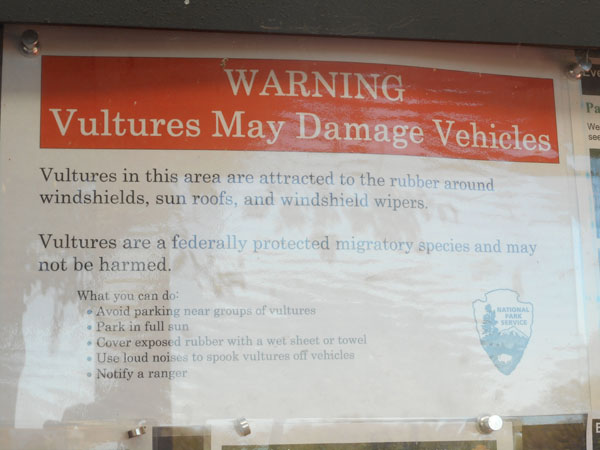 |
| The visitor's center hosted a fledging osprey on its antenna tower |
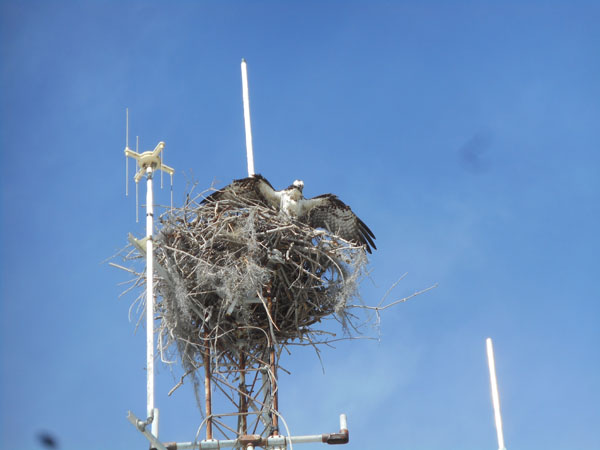 |
| |
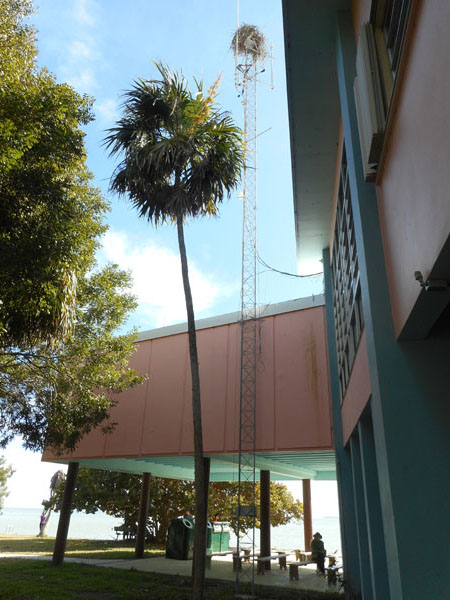 |
| Our beach walk turned up a sternum and ribs of something: allegator, manatee or...? |
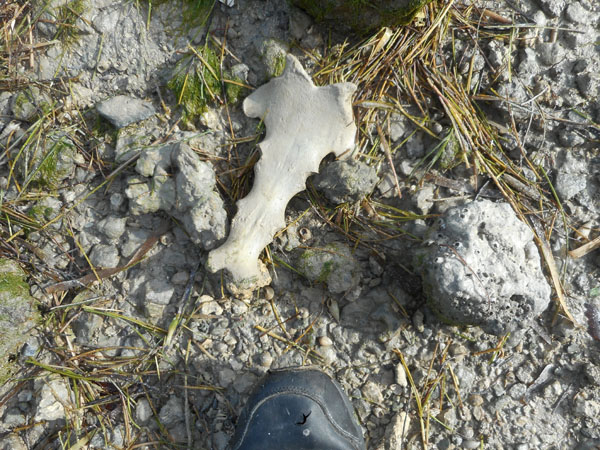 |
more ibis |
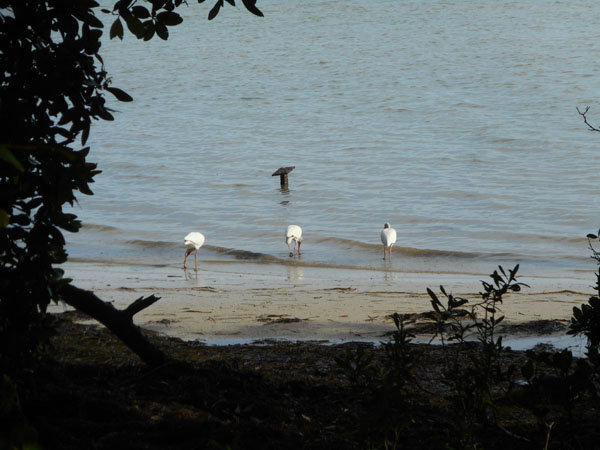 |
| more osprey |
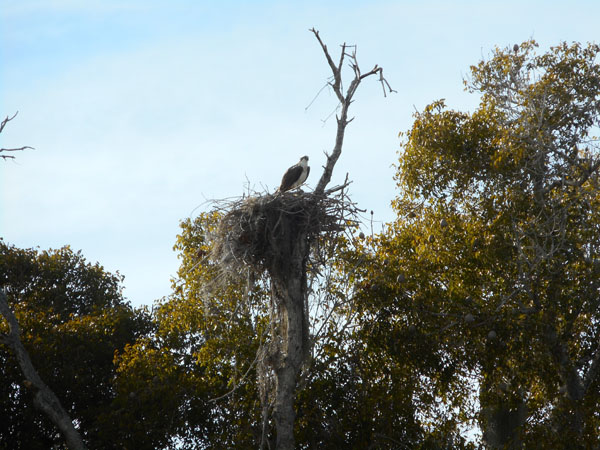 |
festooned trees |
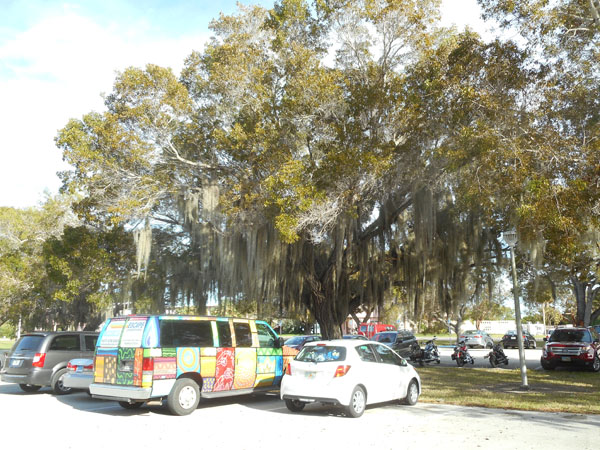 |
| and an unseasonable army of mosquitoes. |
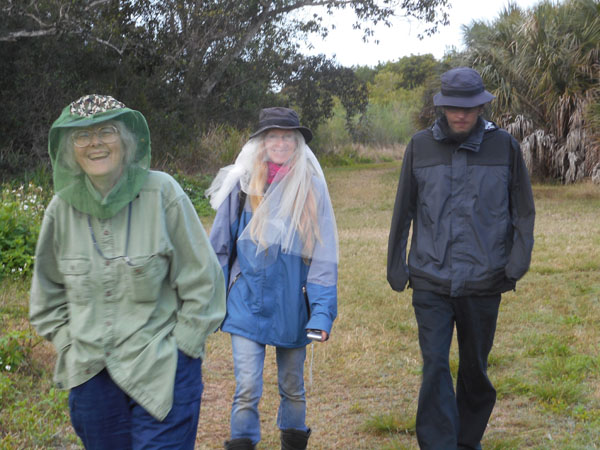 |
| a stop the next morning at Eco Pond for birds |
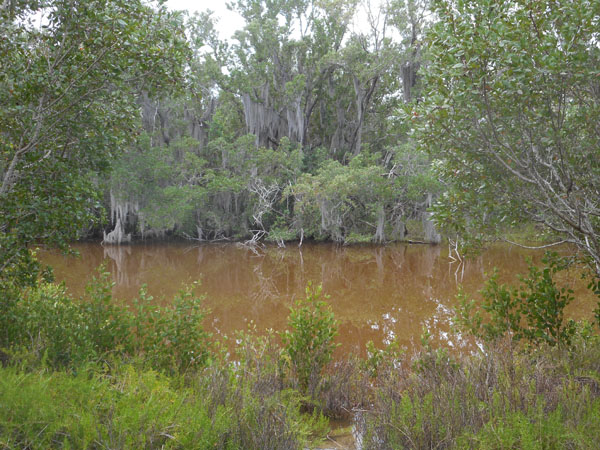 |
| was quite successful |
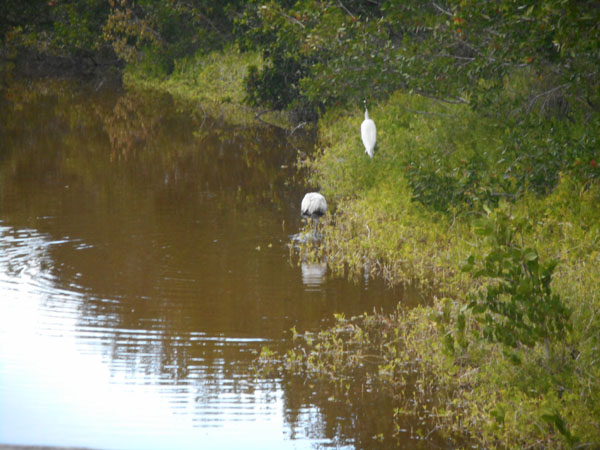 |
| woodstork fishing |
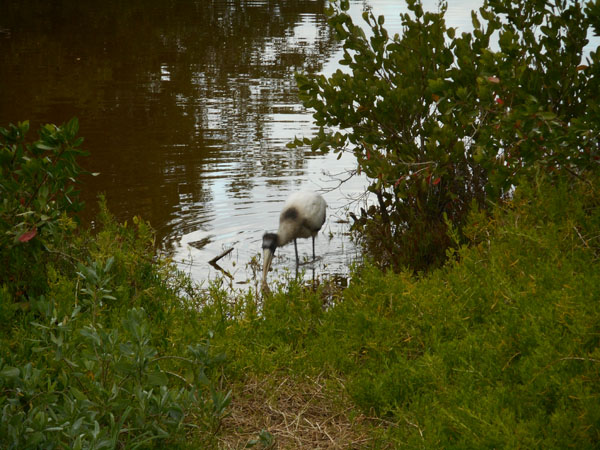 |
| and another posing and looking wise. |
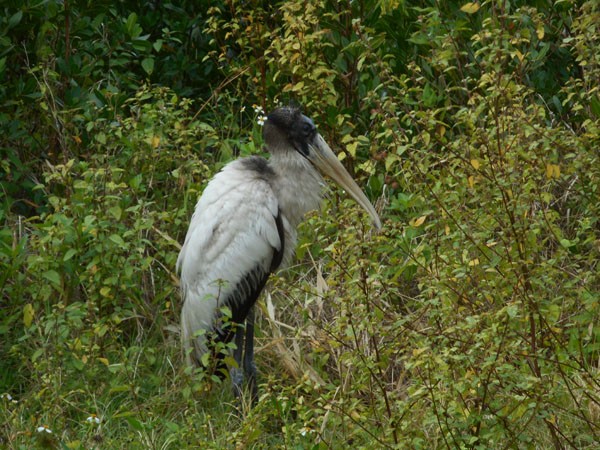 |
| We walked almost all of the trails that weren't underwater: because of El Nino, the areas which are usually dry at this time of year had about a foot of water. |
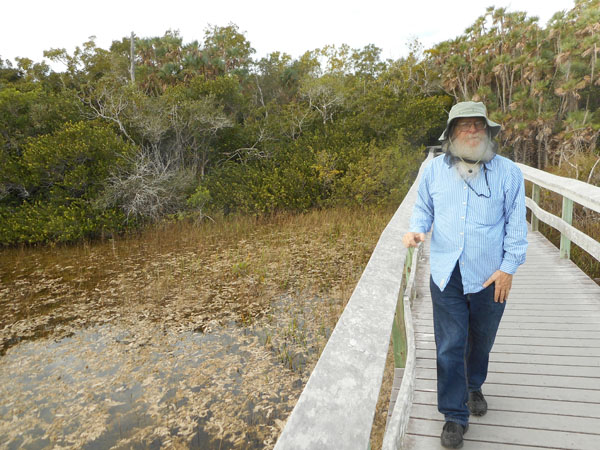 |
| The floating brown algae are the base of the food chain. |
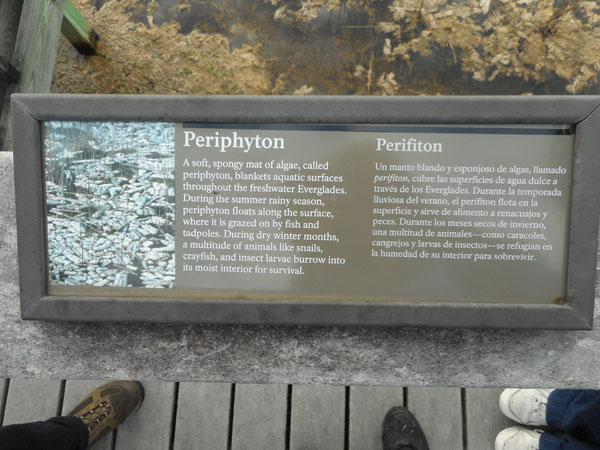 |
| Most of the Everglades are sawgrass prarie (sawgrass is really a reed not a grass; no one argues about the "saw" part of it). When it is dry there are often grass fires set by lightning. Florida calls itself the "lightning capital of the World". |
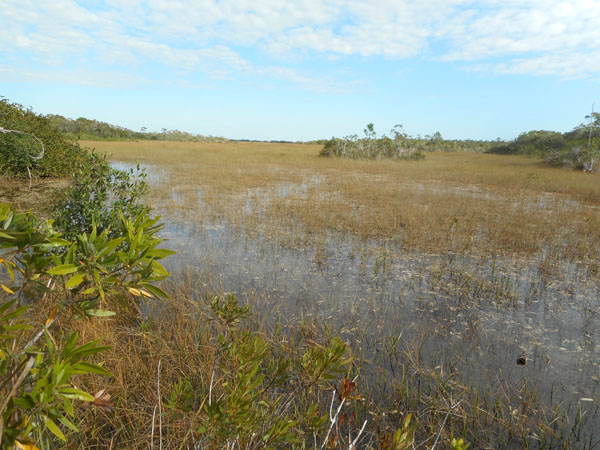 |
A slight elevation change causes islands of different vegetation called hammocks.
A hardwood hammock is high enough to be dry all year. The acidic run-off from decaying leaves etches a deaper moat out of the limestone surrounding the hammock. This is wet all year and so keeps the hammocks from burning as often as the prarie. |
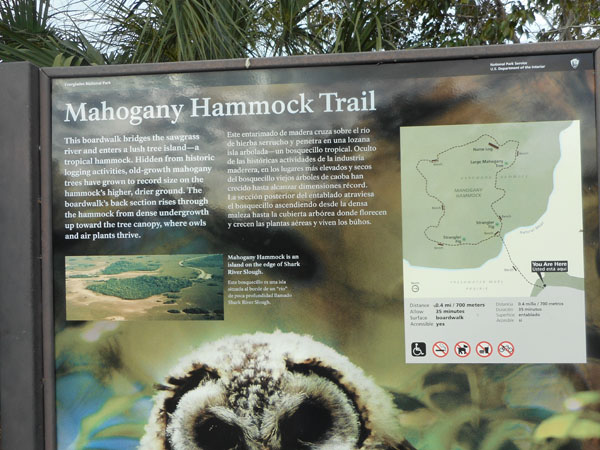 |
| Hammocks have big old trees with lots of epiphytes. |
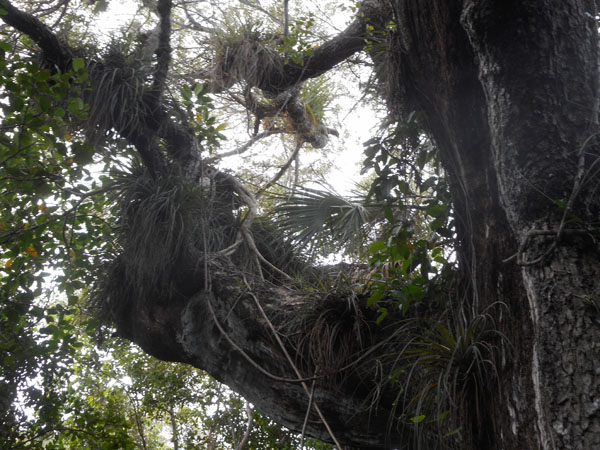 |
| and palms and palmettos |
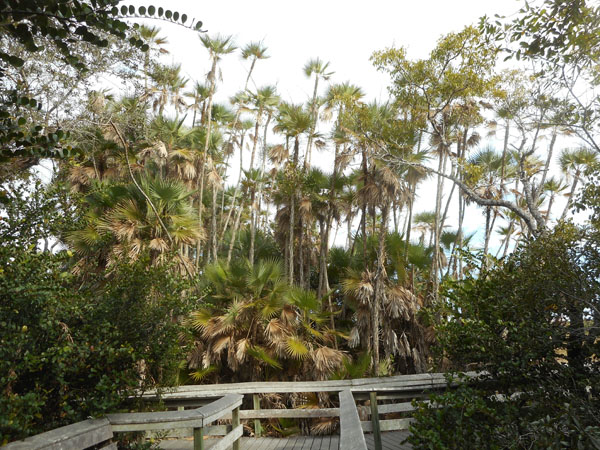 |
The dead-looking trees are bald cypress which lose their leaves in the winter. Cypress hammocks are a bit lower elevation so wetter then the sawgrass prarie.
(willow hammocks are even wetter and green all year) |
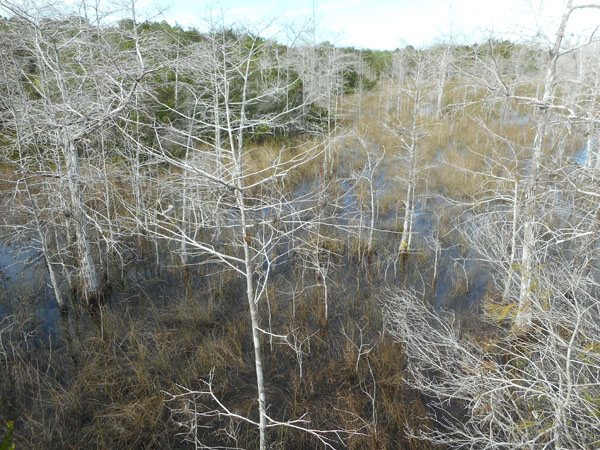 |
| Some cypress were just starting to green up. |
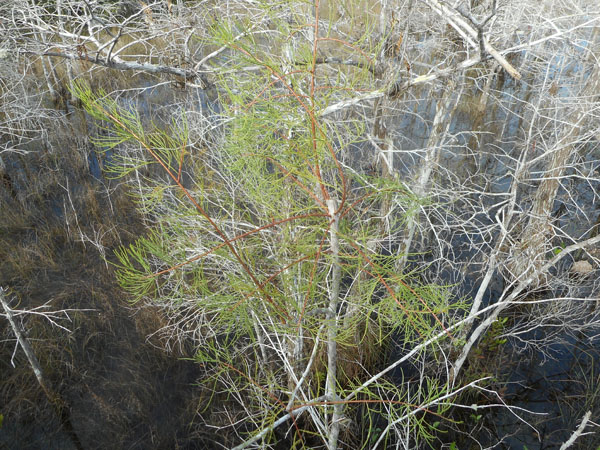 |
| Pinelands are the other major biome, constantly pruned by fire and hurricanes (or they would become hardwood hammocks) |
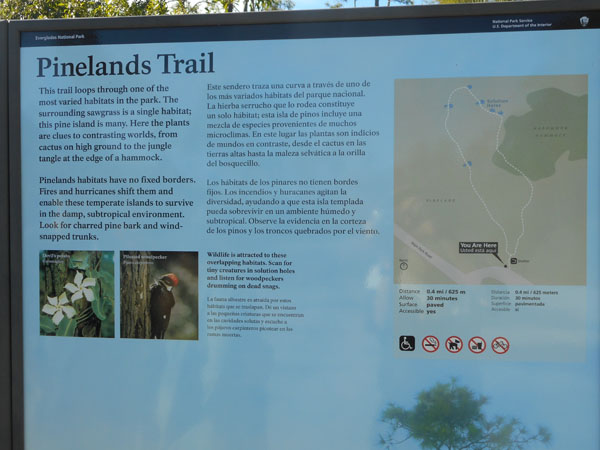 |
| |
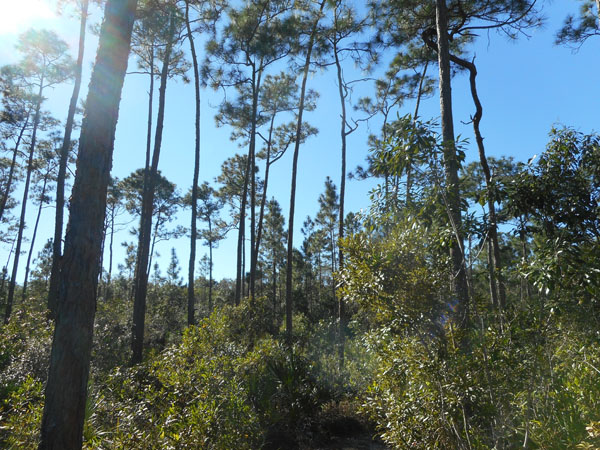 |
| Then there are 'gators. They carve out wallows deep enough to stay wet all year. In normal winters wildlife concentrates around this water during the dry season. This year the wildlife is all spread out because of the abnormally high rainfall. |
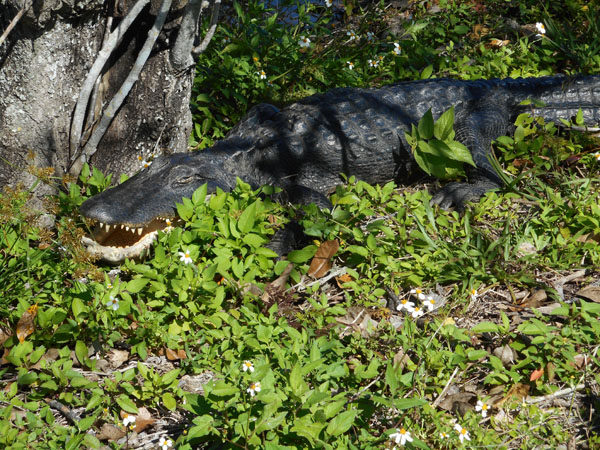 |
| I finally saw a purple gallenule, a very colorful iridescent bird that can walk on water lily pads in the gator holes |
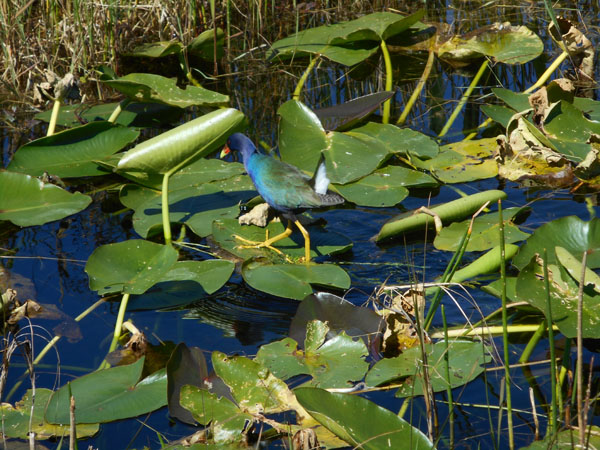 |
| This double crested cormorant (note the hook on end of the bill) hung out near the marsh-monitor camera. |
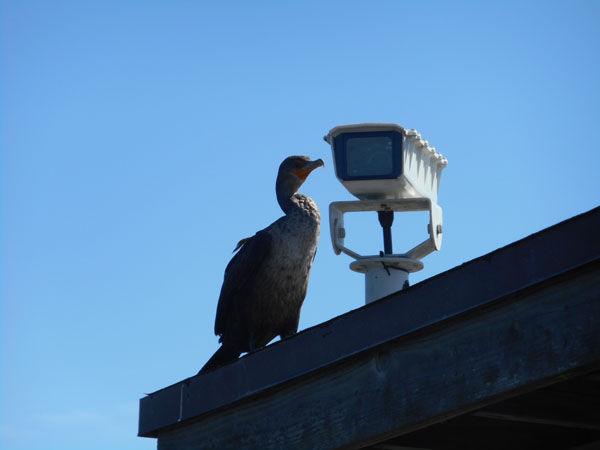 |
The anhinga, on the other hand, has a straight bill. This is a male (neck is black). They are often seen in this pose drying their wings after swimming underwater (remember the "snake bird" from our Rockets and Manatees page?). |
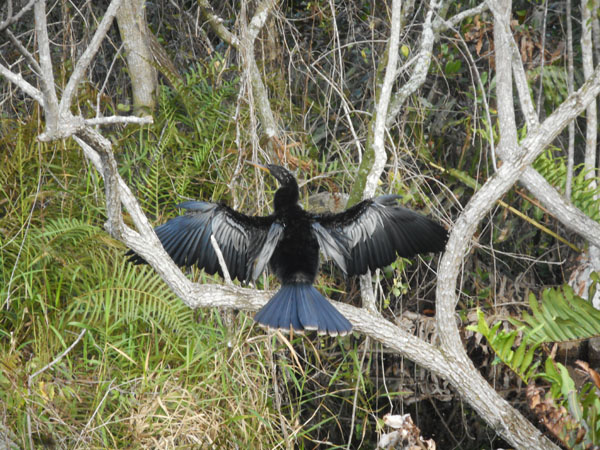 |
This is a female (brown neck) Another common pose is their head-bobbing "looking for fish" action. Here is a thirty-second video of that dance. |
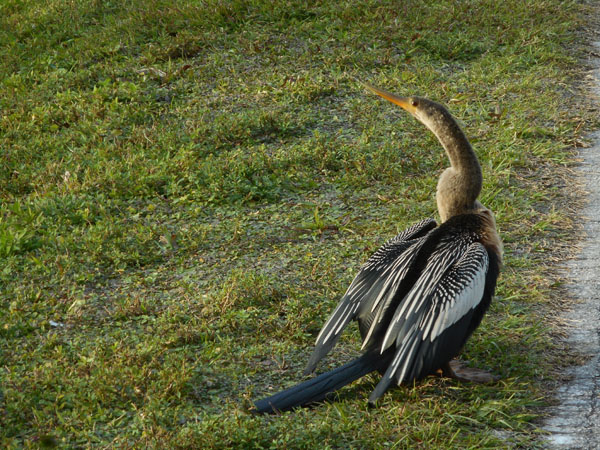 |
Great blue heron. There is a rarer white morph, the "great white heron", that interbreeds with this coloring. It has bright yellow legs unlike the great egret, which has dark gray legs. Here's another thirty-second video of this bird striding along. |
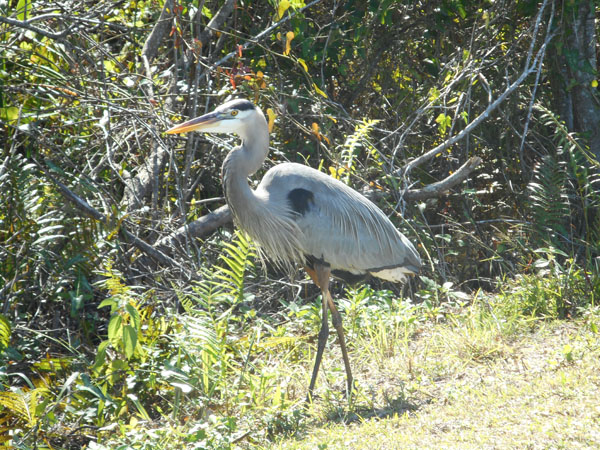 |
| Great egret |
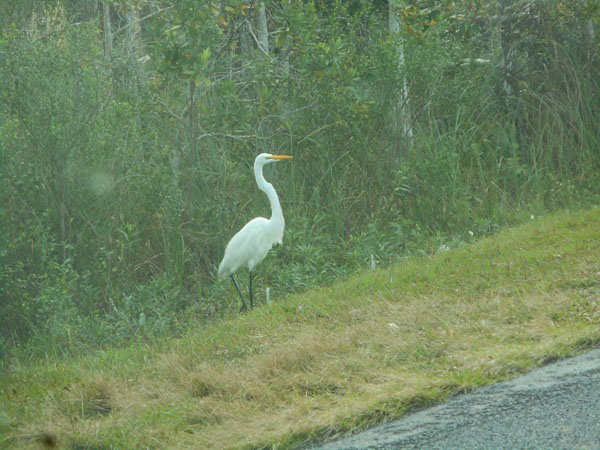 |
| Snails of different colorings/stripings have evolved on each hardwood hammock. |
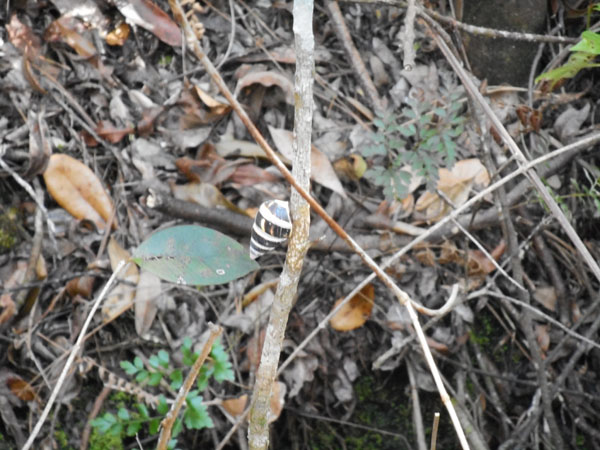 |
| The pretty green anole lizards were a bit more scarce than the brown ones. |
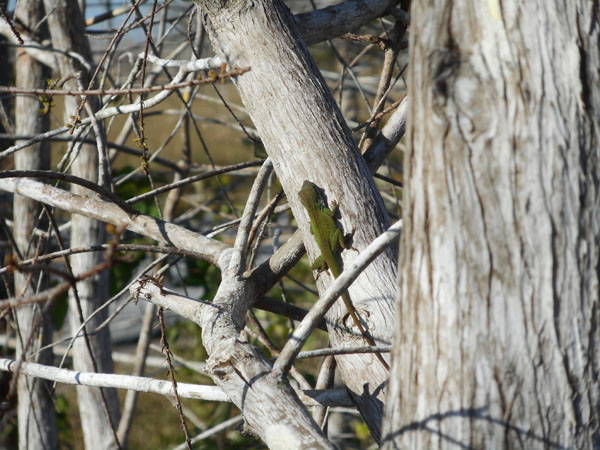 |
| |
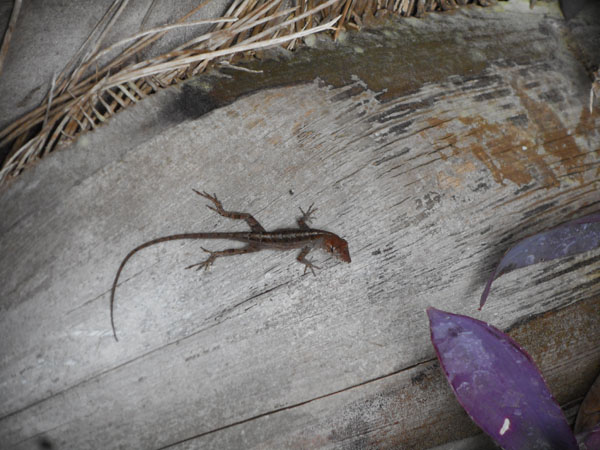 |
We, from states with a bit more elevation, found humor in this sign |
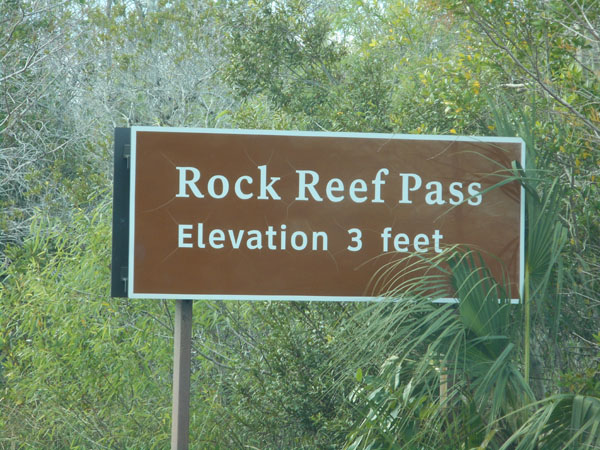 |
| Dick's view of the road |
 |
| We stopped for lunch just outside the park. Dick had gator bites (tastes like chicken) and the rest of us had non-fried things. |
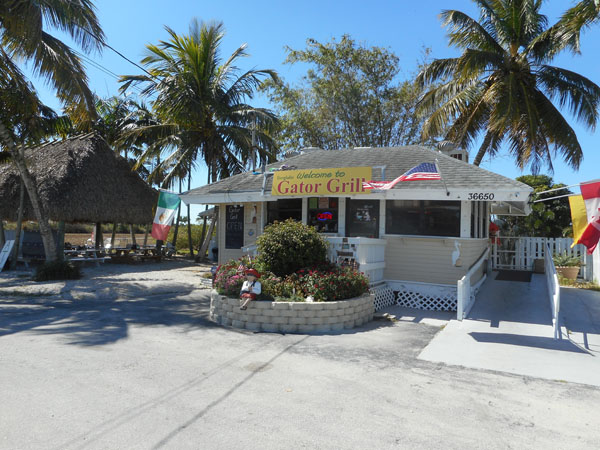 |
| In the afternoon about every half mile you'd see a crow patrolling the roadside. |
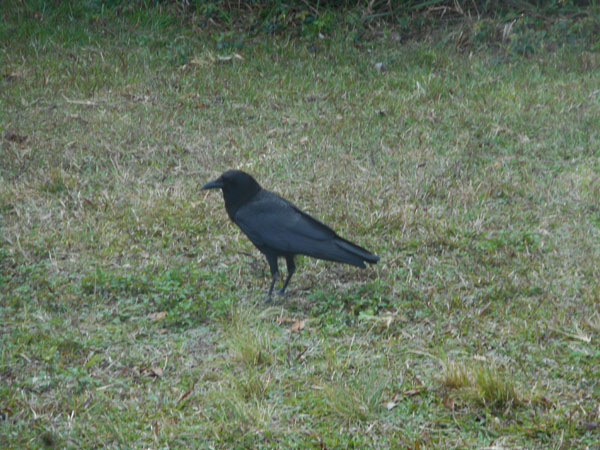 |
| After two nights at Flamingo we decided we'd had enough mosquitoes. Dick drank his morning "camp" coffee (add coffee powder and sugar to half empty cold water bottle, shake well) before setting off to a new campsite on the north side of the park. |
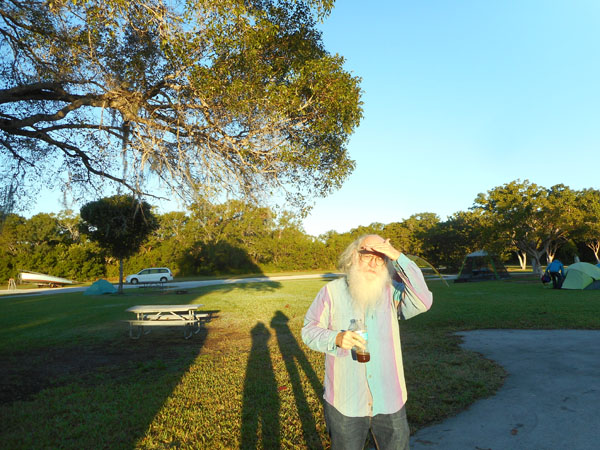 |
North past miles of sawgrass prarie
... which should have been on dry ground at this time of year. |
 |
| and bald cypress |
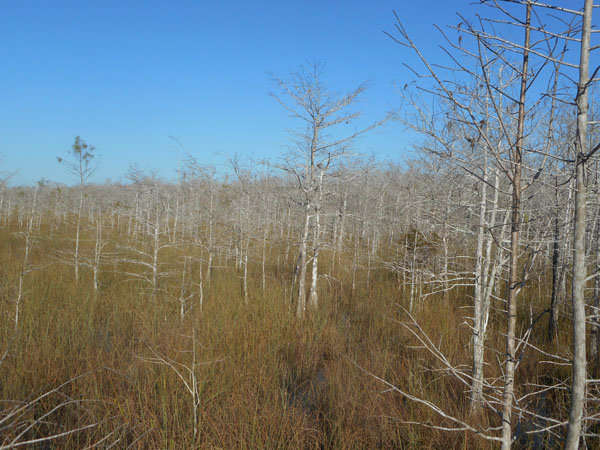 |
| We came to highway US 41 and turned west. Most of the highways have "borrow pits"... canals created when they dug up the limestone next to the road to build the roadbed. These are lined with egrets, anhingas and gators (in the Micosukee Indian Village they have put out old tires which look like gators from a distance and make the tourists slow down) |
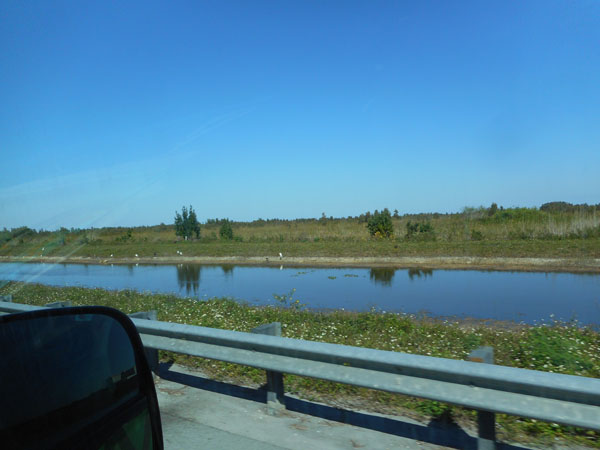 |
| Midway campground, in the Big Cypress National Preserve, had lots fewer mosquitoes than Flamingo. But not "zero". |
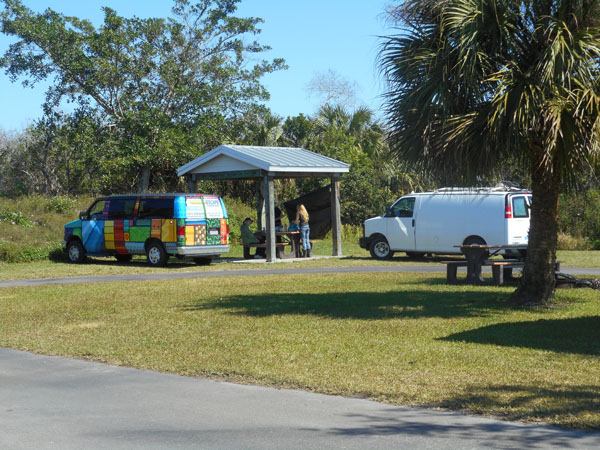 |
| After setting up camp we drove the "Loop Road" in Big Cypress. This was the Florida I was hoping to see. |
 |
| |
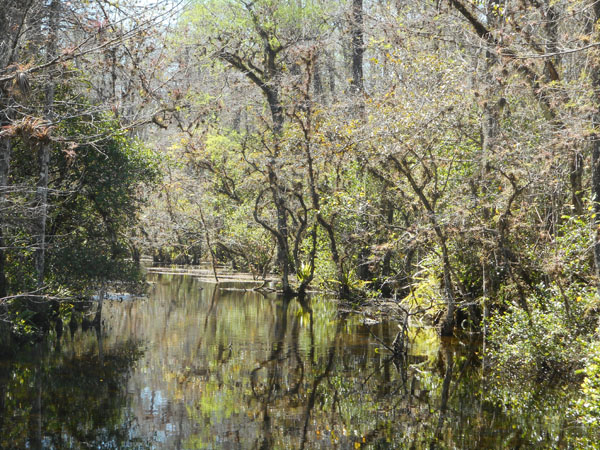 |
| |
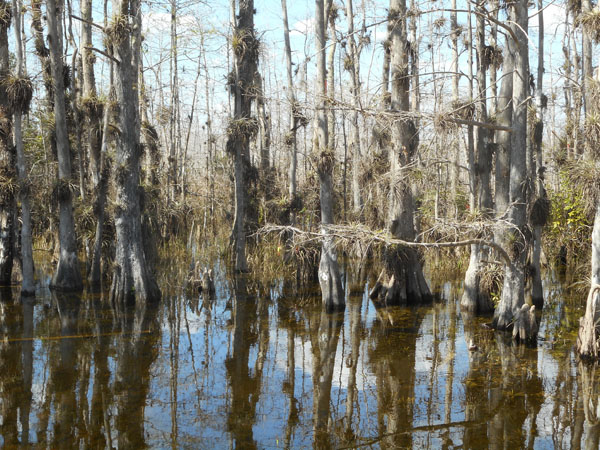 |
| Every wide spot along the narrow one-lane dirt road had something fascinating lurking nearby |
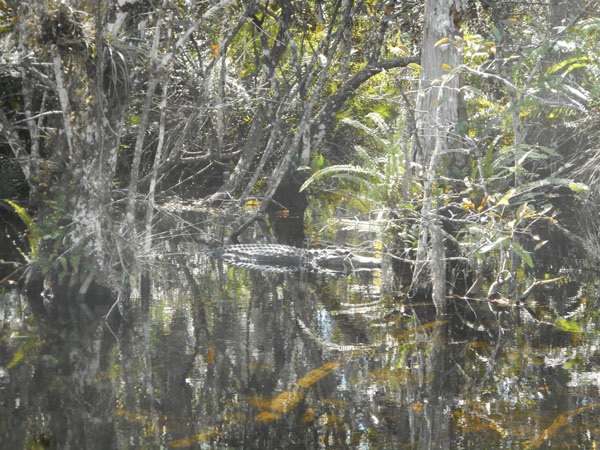 |
| |
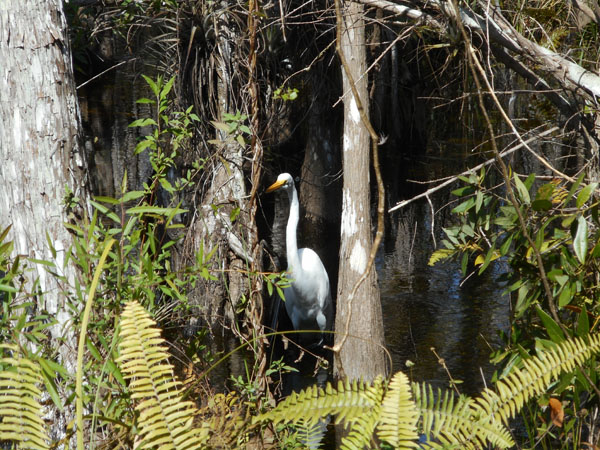 |
| Some gators do look like old tire treads. |
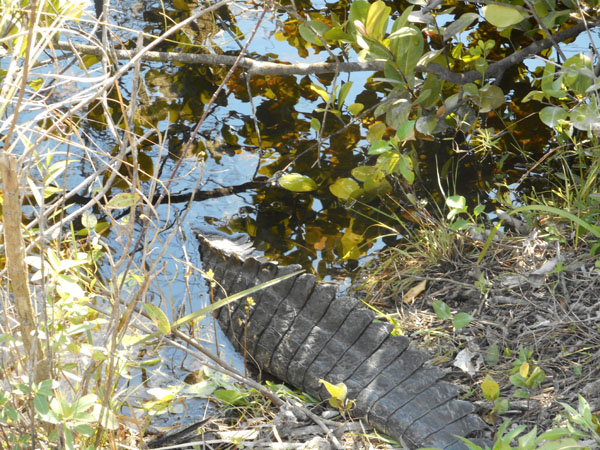 |
| After finishing the loop we drove east to the Shark Valley visitor's center in the Everglades National Park. Because it was so late we walked around and deferred taking the tram to another day. |
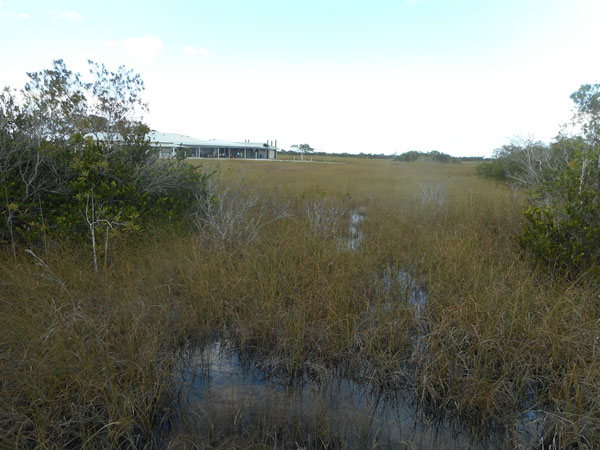 |
| The easy walks consisted of the Bobcat Boardwalk (with this sign), a walk along the Tram Road, and a side trail called "Otter Cave" |
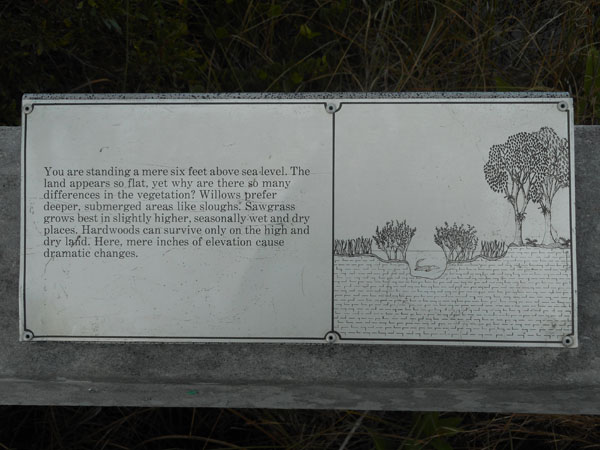 |
| Oops ... the ground-level trails were flooded |
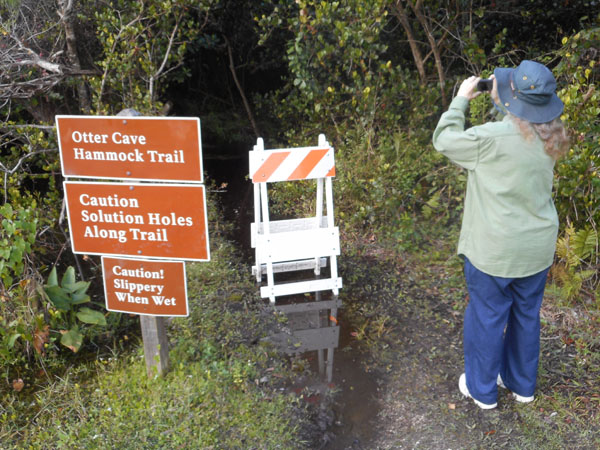 |
| The walking we did was mainly along a road with a borrow pit canal full of wildlife. Note gator. |
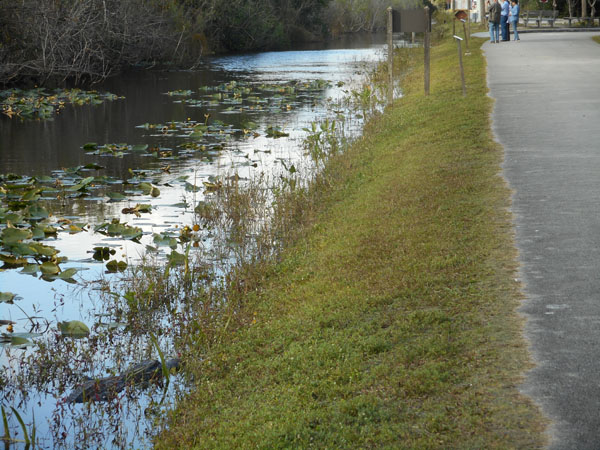 |
| |
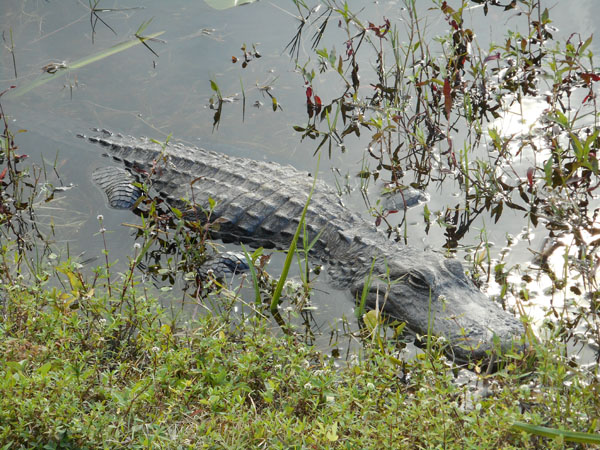 |
| little blue heron |
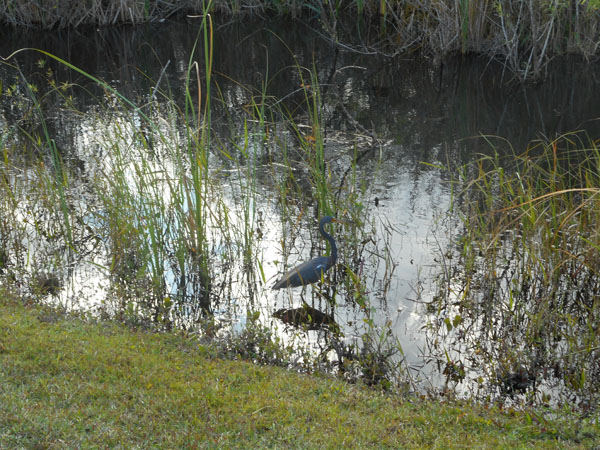 |
| The water was very clear. We spent several minutes watching this ahninga fishing: swimming underwater for several yards and then putting its head up to breathe and sometimes swallow a fish, repeat. |
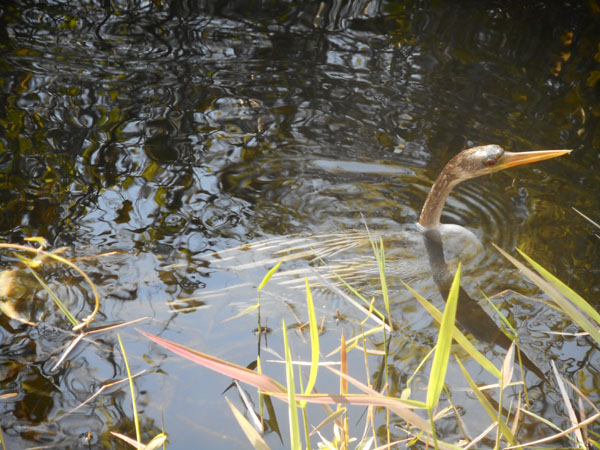 |
| limpkin |
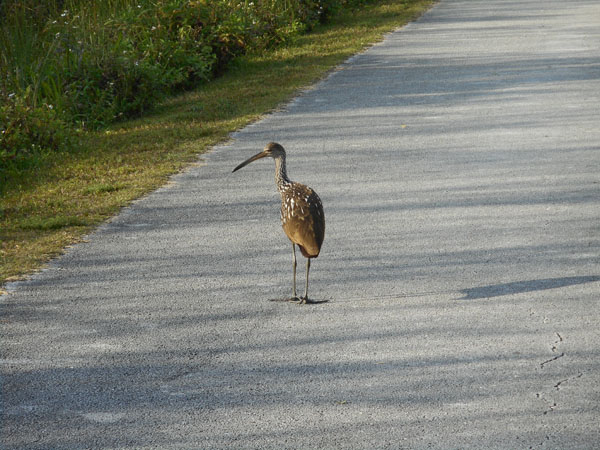 |
| vultures |
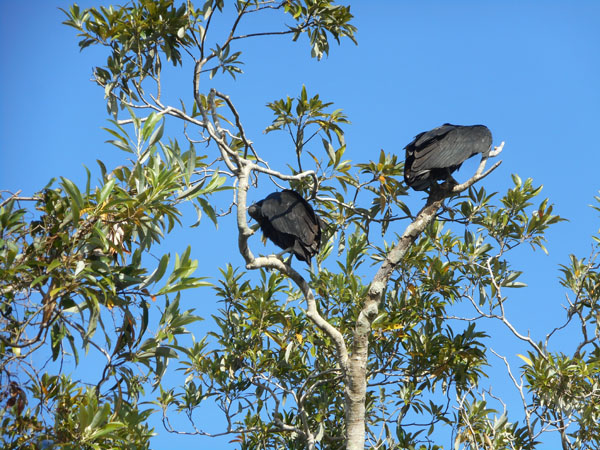 |
| baby gators |
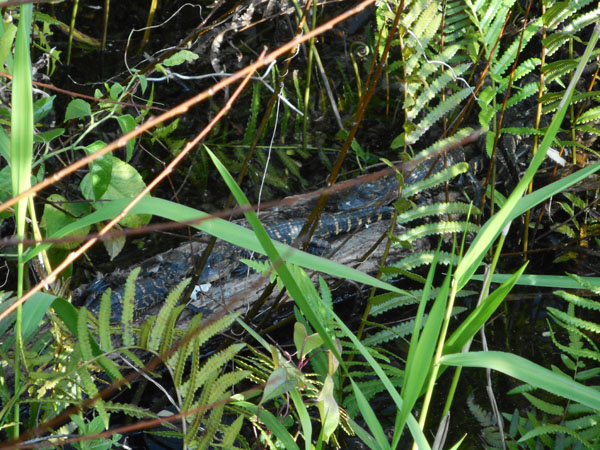 |
| and far more adult gators than Karen wanted to encounter at close range. |
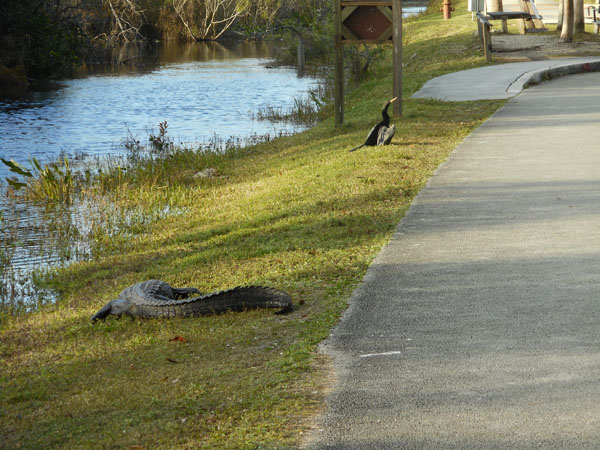 |
| Dick was taking a photo of this sign and didn't even see the gator under it. He wonders if the gator was thinking: "Hmmm... tasty toes?" |
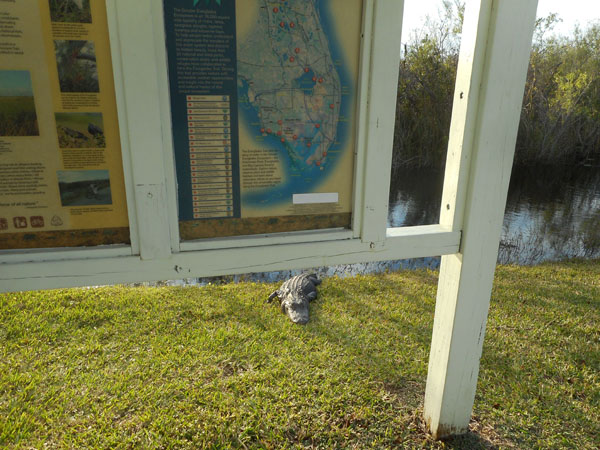 |
| The next morning we walked the Kirby Storter boardwalk in the Big Cypress Preserve. This was Karen's favorite. |
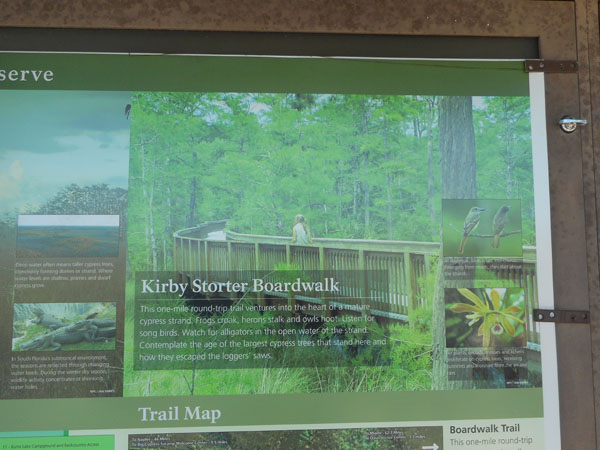 |
| We saw otters, turtles, gators, lizards, fish, red-cockade woodpeckers and other birds in a serenely beautiful setting just feet off the highway. |
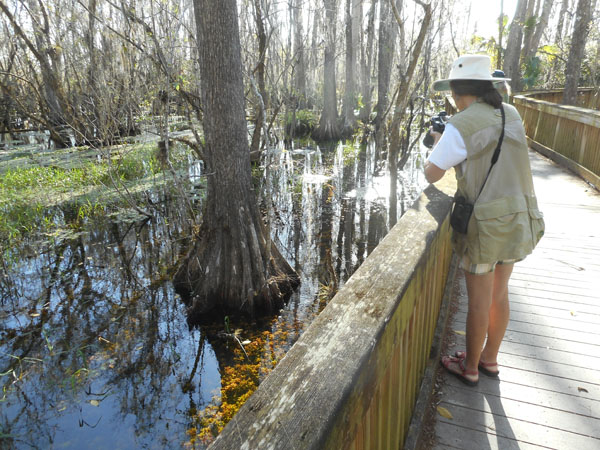 |
| |
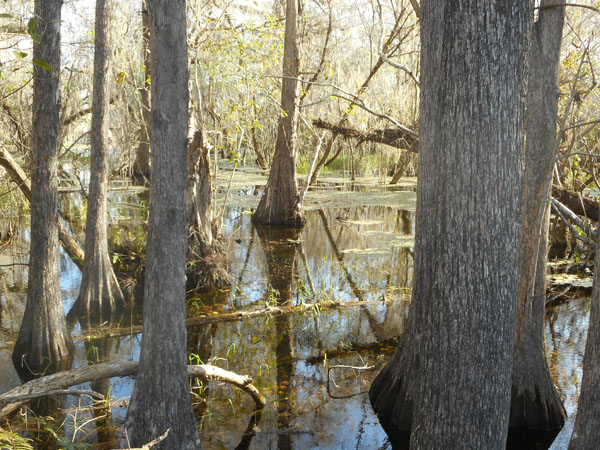 |
| |
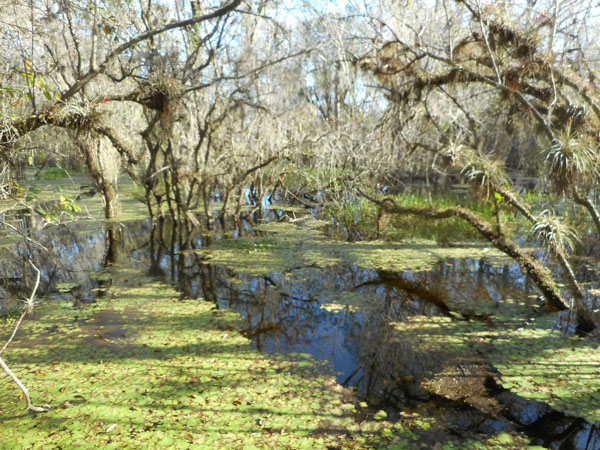 |
| A turtle revealed by the vegetation jerking, then disappearing from the water's surface. |
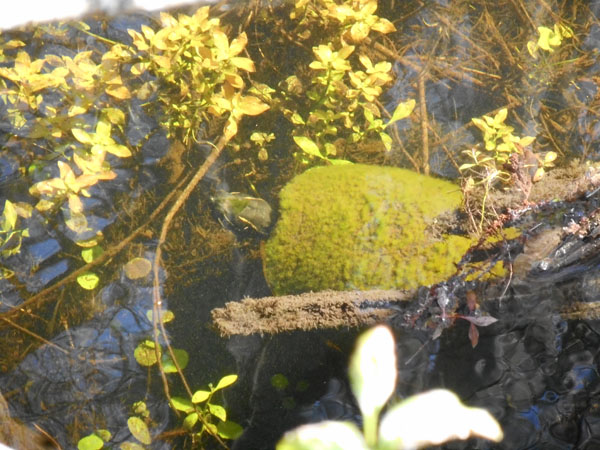 |
| |
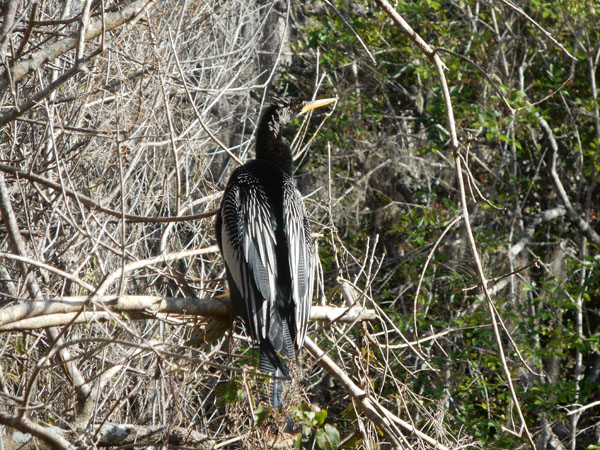 |
| |
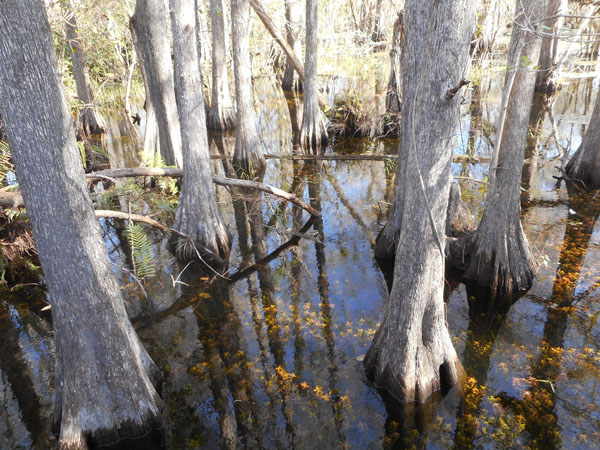 |
| Unexplained rapid ripples off in the distance suddenly turned into a River Otter's head! |
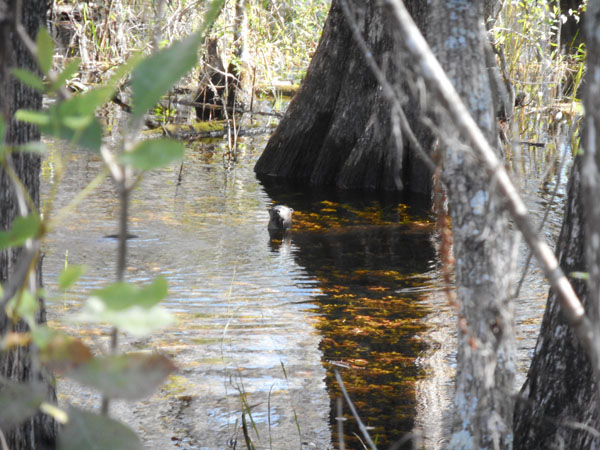 |
| As we left we saw this American bittern trying to pretend it is grass. |
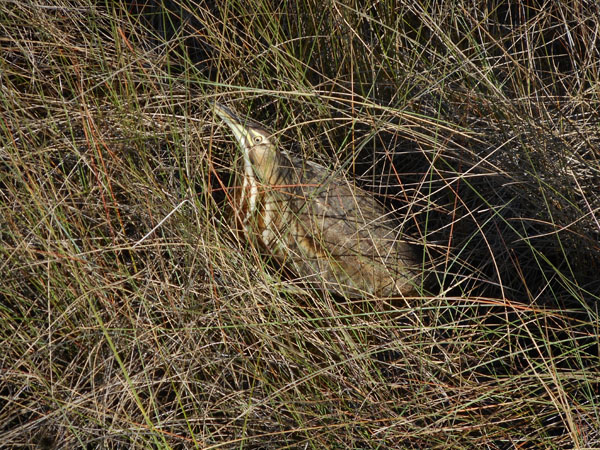 |
| Then we were off to the Big Cypress Welcome Center. This gator was part of a display, but it took a moment to figure out it wasn't real. |
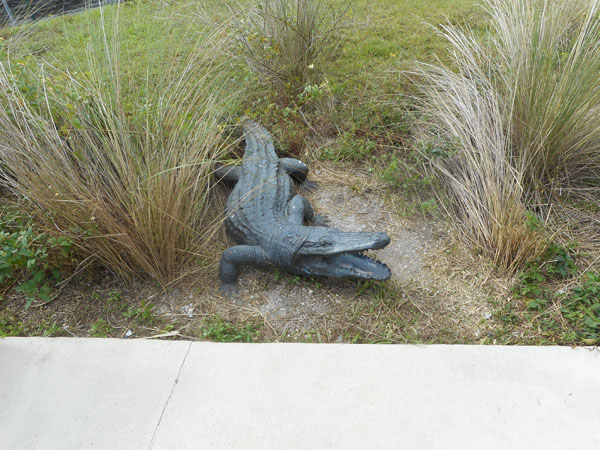 |
| Inside is a comparison of the skulls of the American Crocodile (left; rare and mostly salt water) and the Alligator (right; lots and mostly fresh water) |
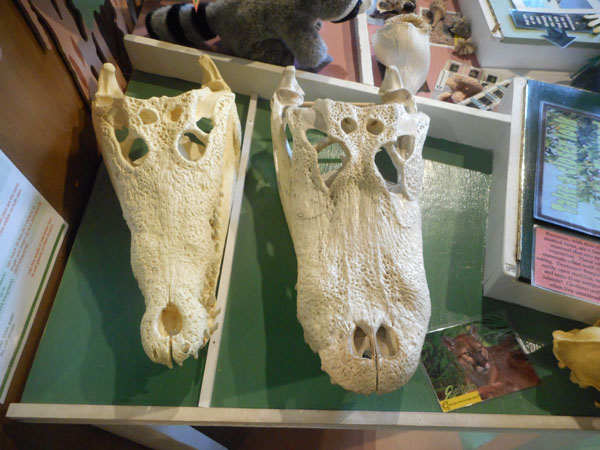 |
Behind the Welcome Center was a short boardwalk.
Sometimes we saw gators, but this time there were manatees |
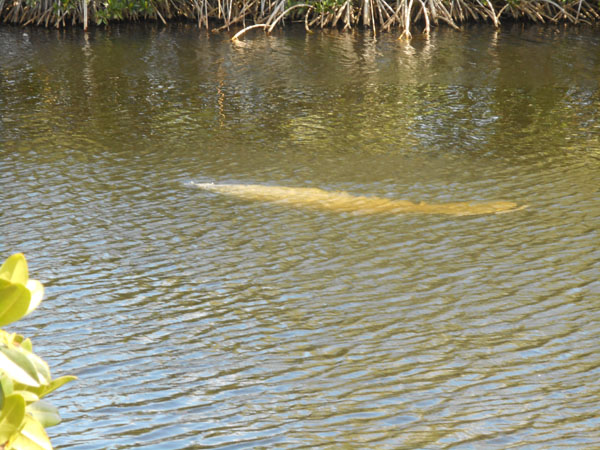 |
| |
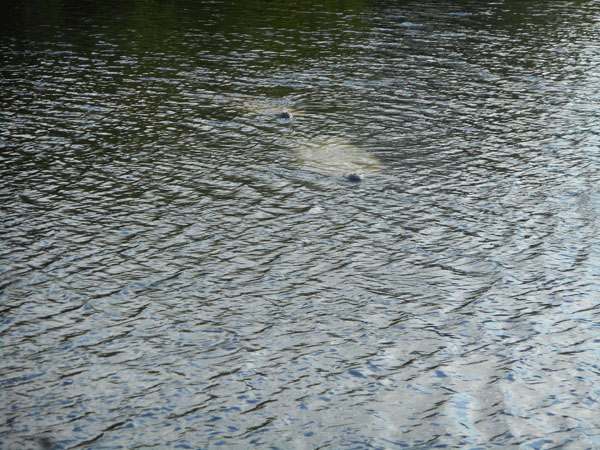 |
| The next few nights we were in Trail Lakes Campground. Unlike the national park campgrounds, and for not much more money, they have a laundry, and hot (sometimes) showers. |
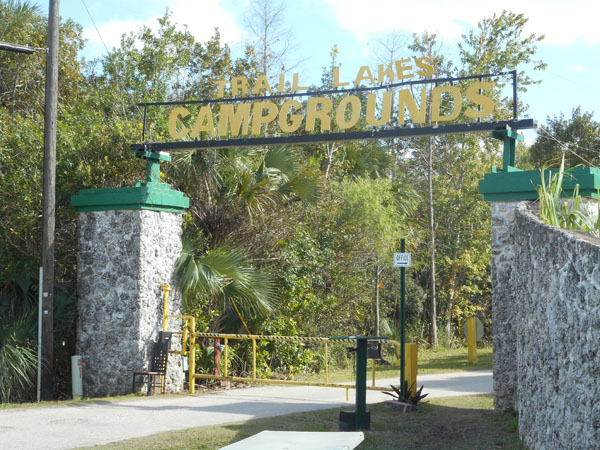 |
| and they have a wacky sense of humor |
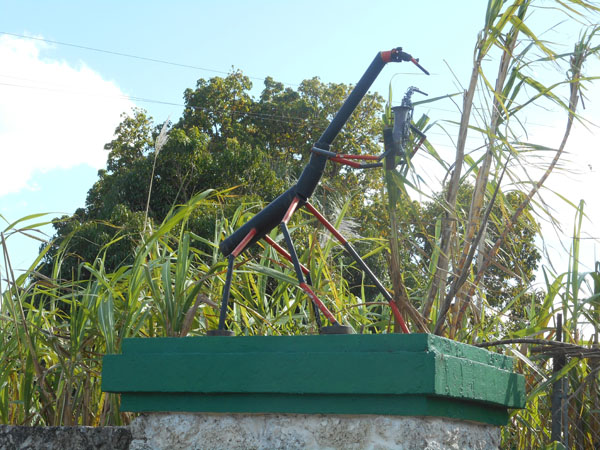 |
| Nice campsite next to a pond. |
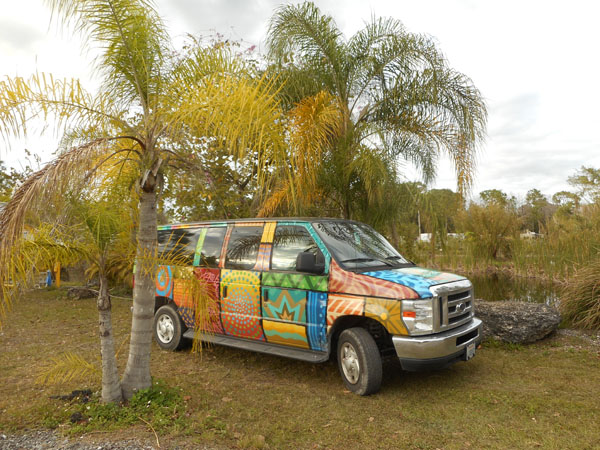 |
| That evening we took the north loop road. Not near as scenic as the south one. |
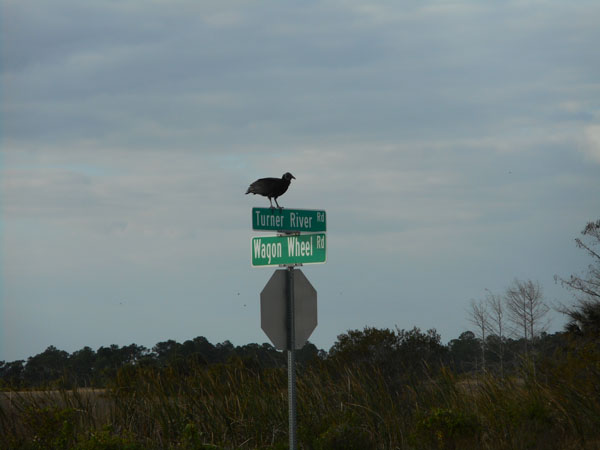 |
| But with great clouds |
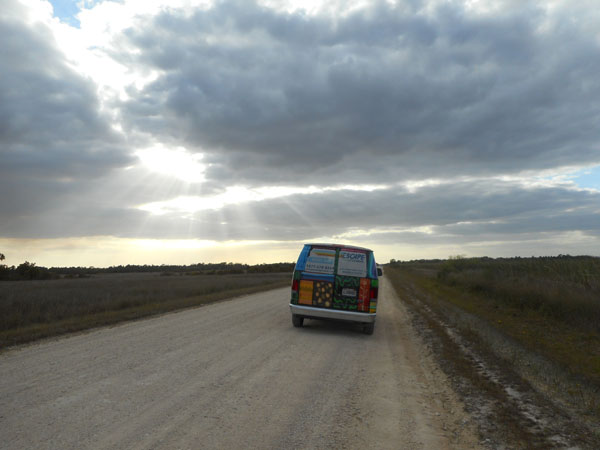 |
| snake in road with gravel |
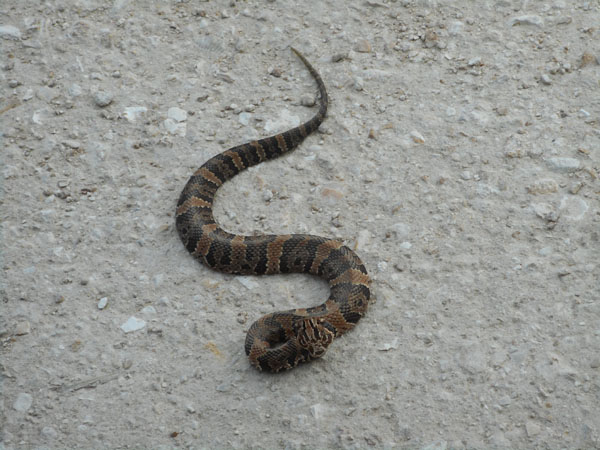 |
| Great egret, one of many |
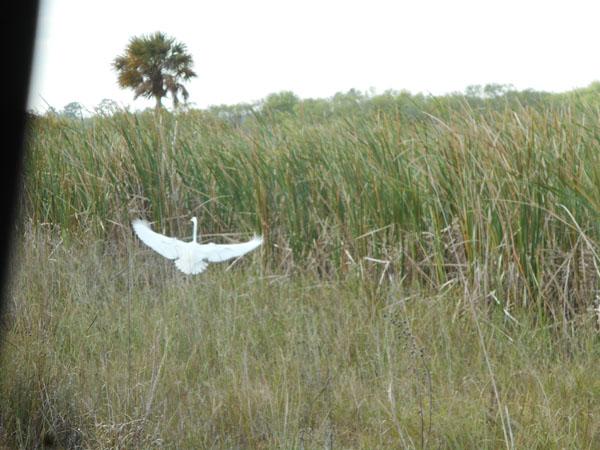 |
| Saw only this one juvenile gator but many adults |
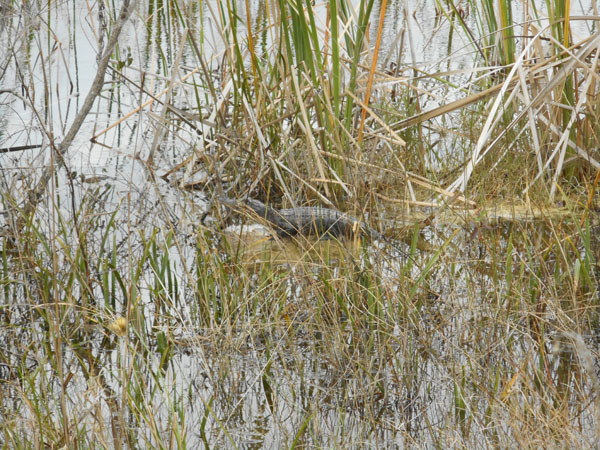 |
The next (Saturday) morning we started out to explore "Janes Scenic Drive", but we were warned that (a) flooding had made it much more difficult and (b) the entry gate was about to be the finish line for a major marathon coming down the Drive.
We decided to defer it to the next morning.
But we had started the attempt by coming across this Vulture conclave |
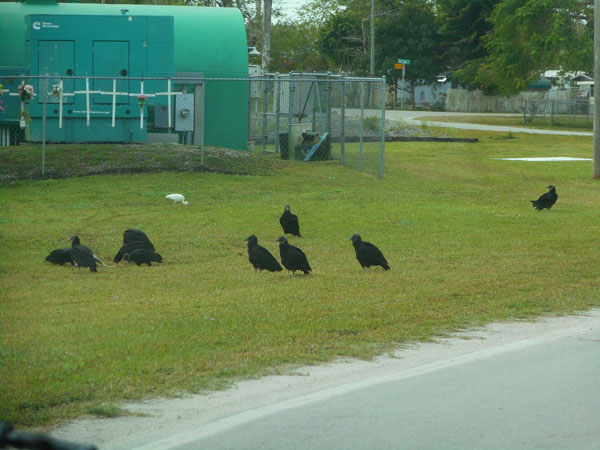 |
| So we set off to the next (along route 41) attraction: the Big Cypress Bend Boardwalk in the Fakahatchee Strand Preserve State Park. A "strand" is a large linear hammock. Here's the pool outside the visitor center. We saw this mother gator again on our way out. |
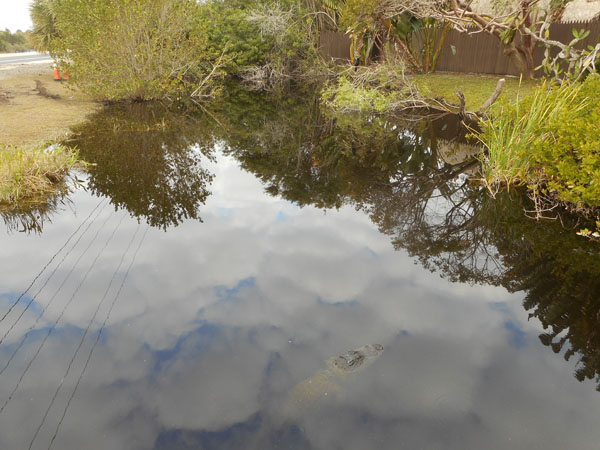 |
| Unfortunately most of the the large cypress trees were logged during WWII: it mostly looks like a slash pile now. But it is wild enough to have an eagle's nest and in time the trees will grow large again. |
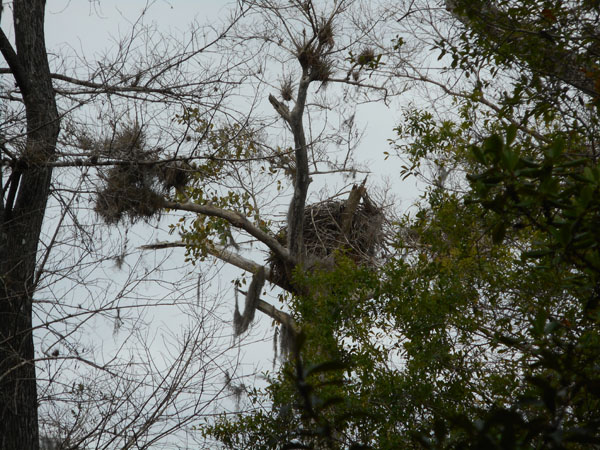 |
| Strangler Fig, showing why it's called that. |
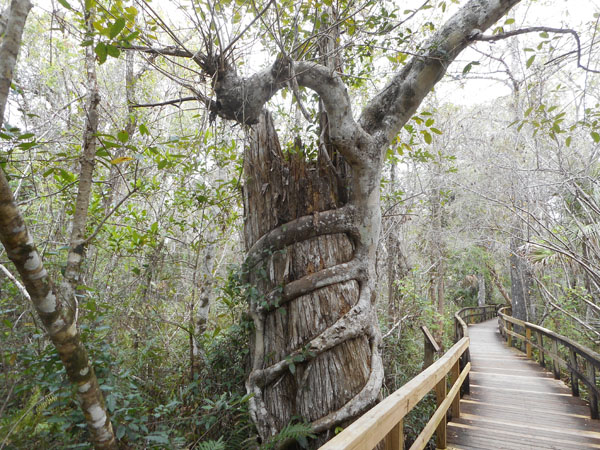 |
| |
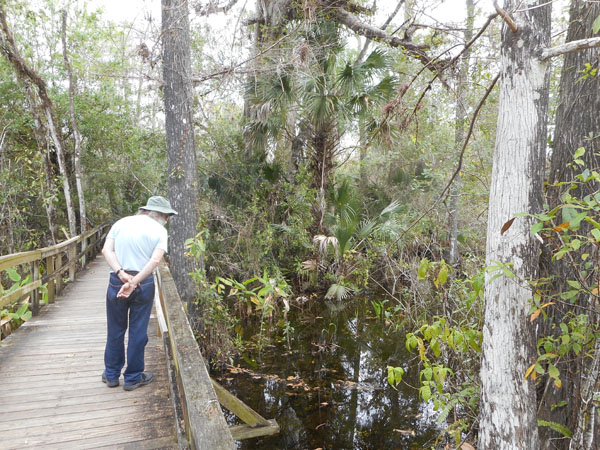 |
| |
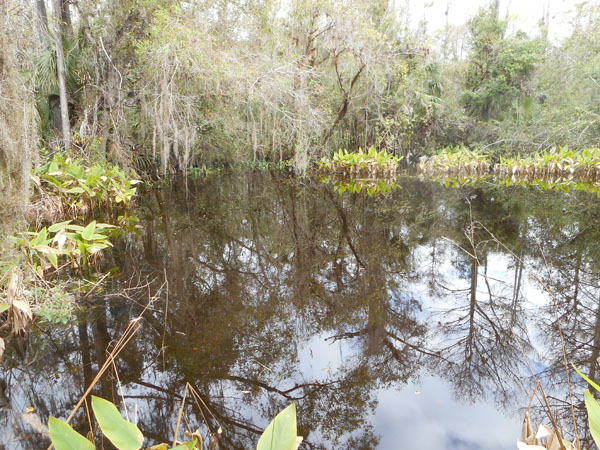 |
| male anhinga |
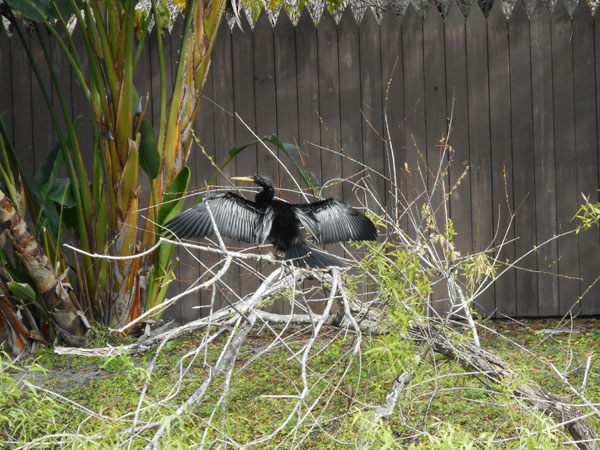 |
Back out at the street-side front pond, we discovered that mama gator had charges: these Baby gators were sunning themselves near the visitor center's door. Yep: more videos: watch one drop into the water near Mom's nose here, and watch a couple cutely squirming here. |
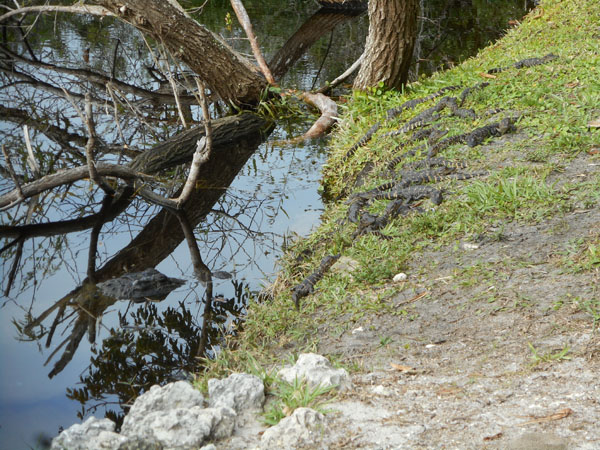 |
| Further west on Highway 41 took us to the Ten Thousand Islands National Wildlife Refuge Marsh Trail. It's an abandoned road that leads out between saltwater ponds and mangroves. Here a woodstork hunts dinner beneath a red mangrove. |
 |
| Meanwhile, on the other side of the trail, a great egret hangs out in the sawgrass. |
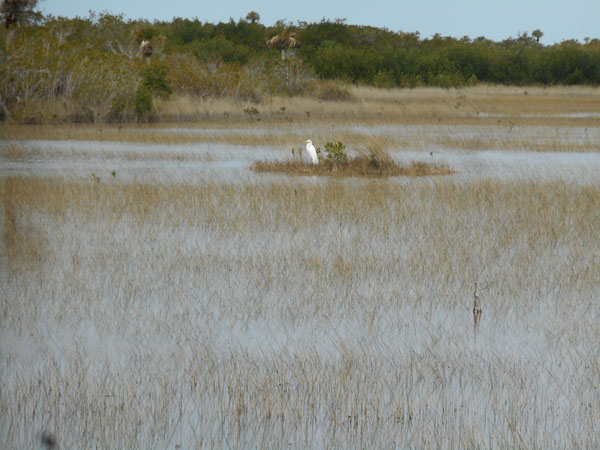 |
At our feet was probably a native indigo snake.
There are supposedly thousands of Burmese pythons which are eating all the small mammals and birds but no one sees them. We did notice that there were more birds closer to towns. Is it due to more food or fewer pythons? |
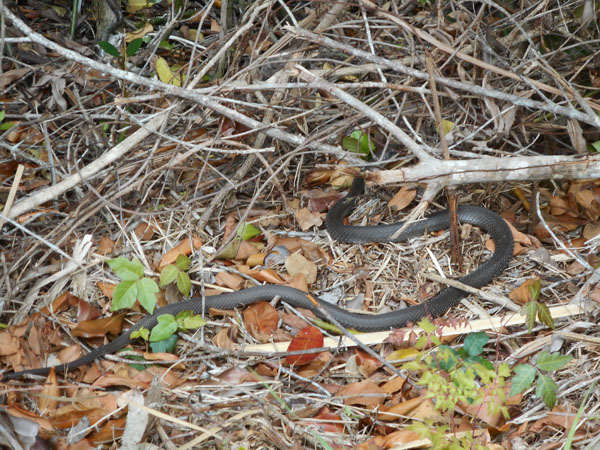 |
| Little blue herons stalking things in the sawgrass |
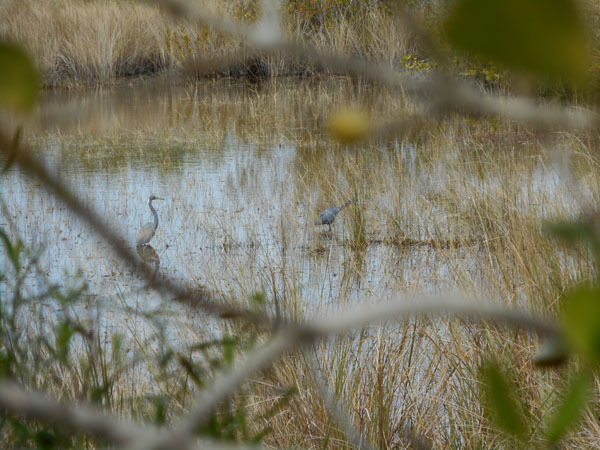 |
| The next day we stopped through the Naples Botanical Garden. A very well laid out display and highly recommended. Peaceful pools |
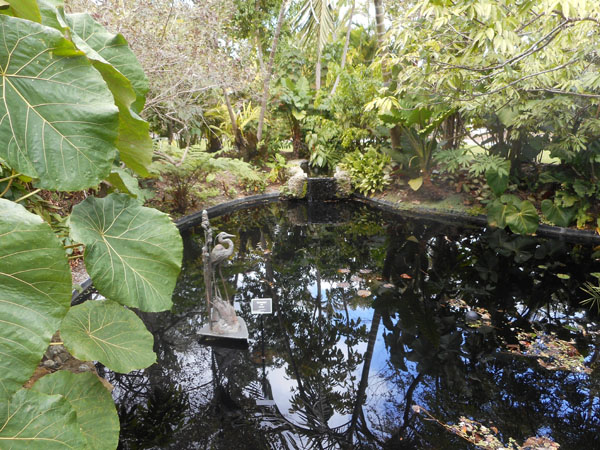 |
| |
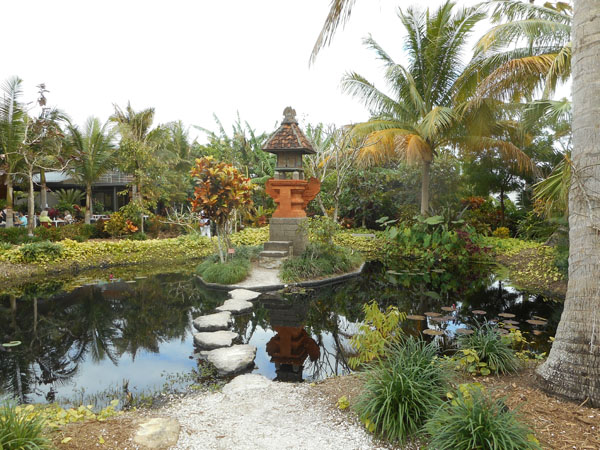 |
Lots of unusual plants and flowers, chosen as examples of what can grow in the latitude band from 26 degrees north to 26 degrees south (with a few extras thrown in).
trumpet flowers |
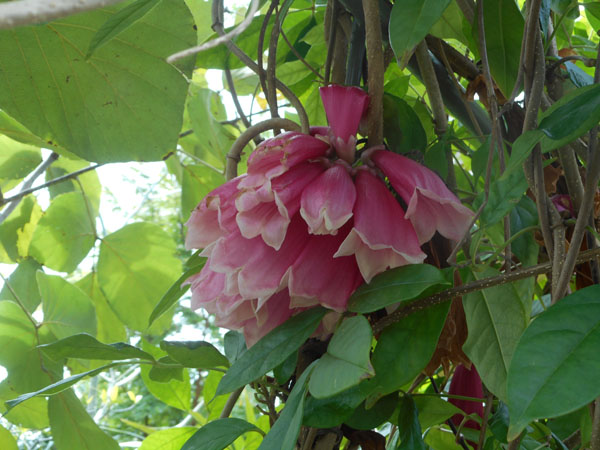 |
| Blue potato tree |
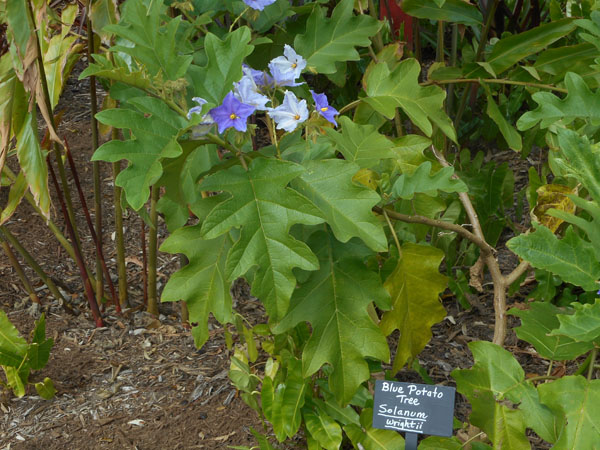 |
| powder-puff tree? |
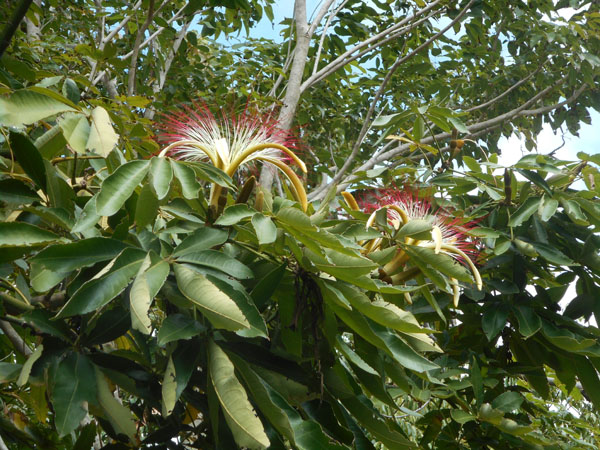 |
| water lilly |
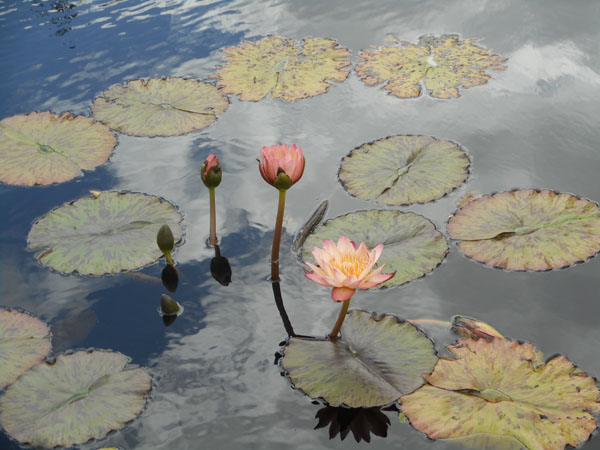 |
| Banana flower |
 |
| collections of tropicals from bromiliads... |
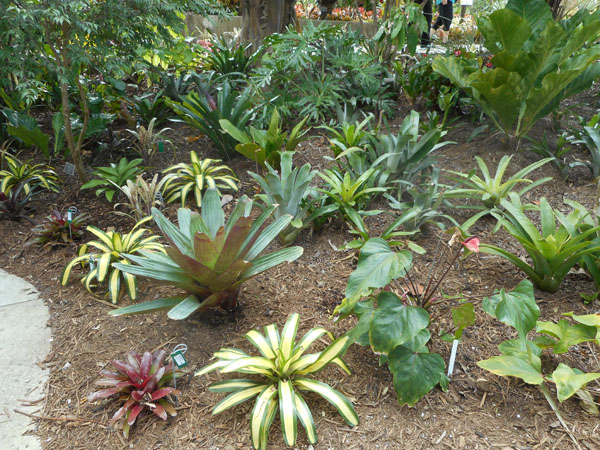 |
| to South African trees |
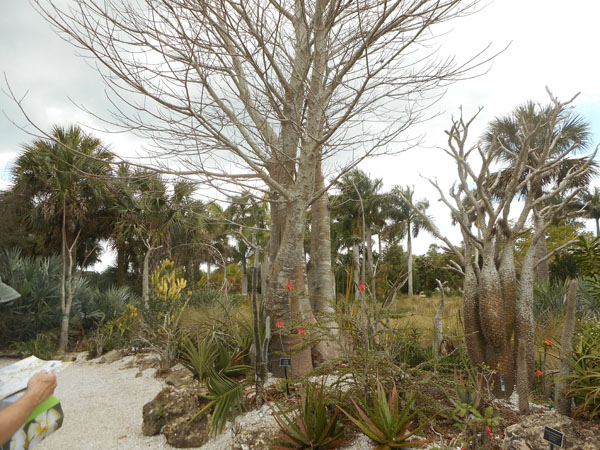 |
There was a display of Lego statues among the plantings A life-sized gardener |
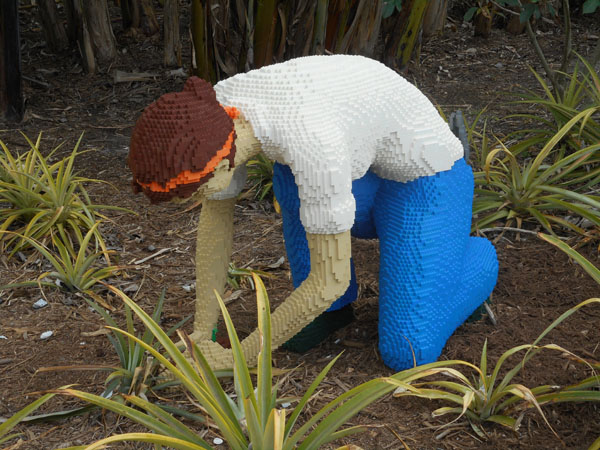 |
| A bit over-sized butterfly and blossom. |
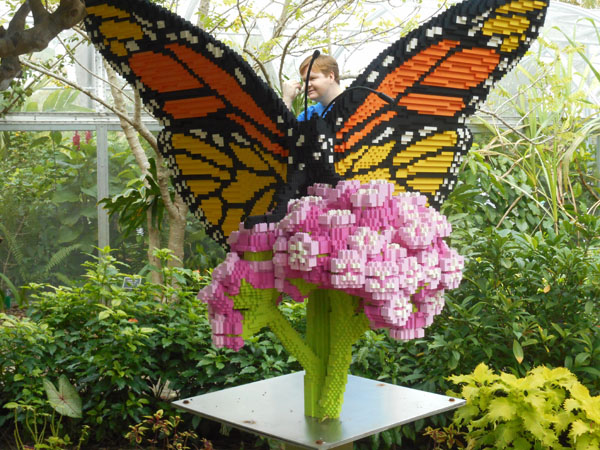 |
| and the usual (non-Lego) wildlife |
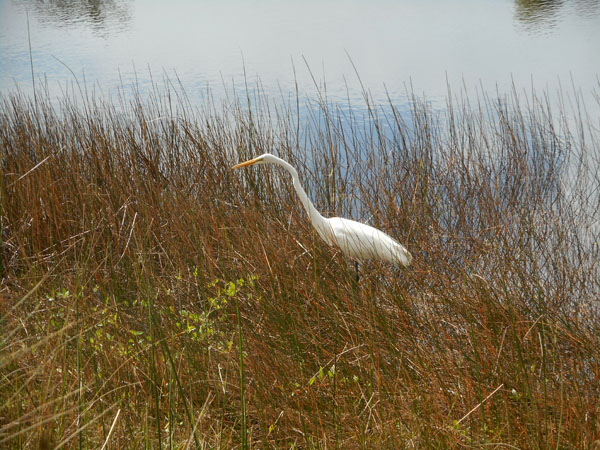 |
| Just a bit south is the Rookery Bay Boardwalk. |
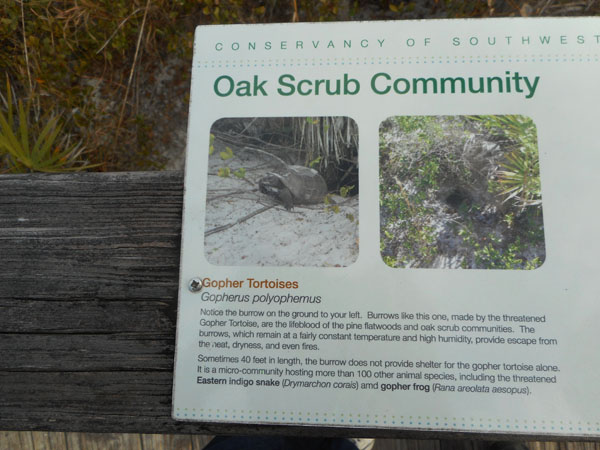 |
| It had had a controlled burn to simulate the lightning-started blazes this biome would naturally experience |
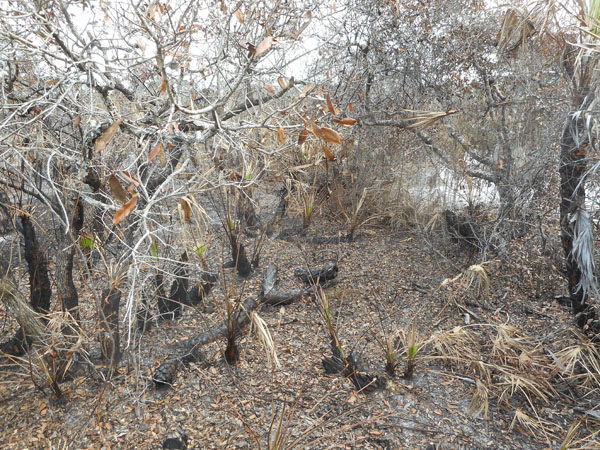 |
| On the other side of the boardwalk was the untouched scrub forest. |
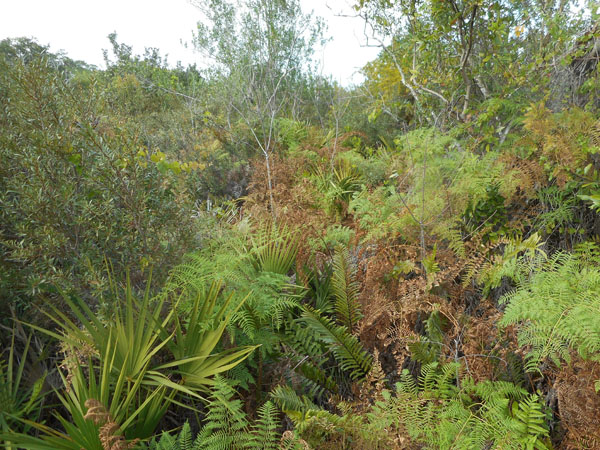 |
| The next morning we took Janes Scenic Drive: lots of wildlife but not very interesting plant vistas as it too goes through the heavily logged area |
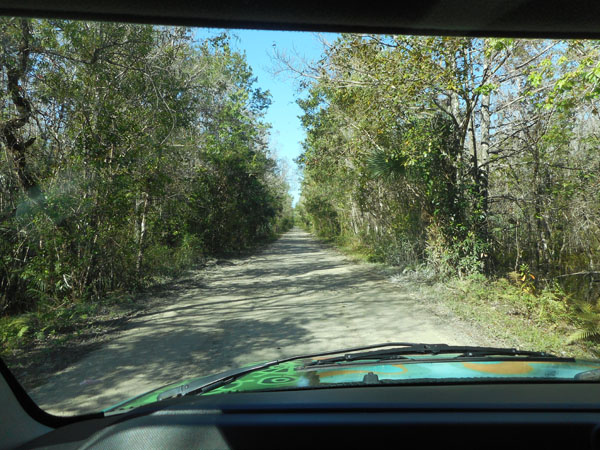 |
This is the road the marathon had used the day before.
Today we encountered a roadblock: a moving gator. ...and, if it was moving, that means there's a video of the alligator leaving the road. |
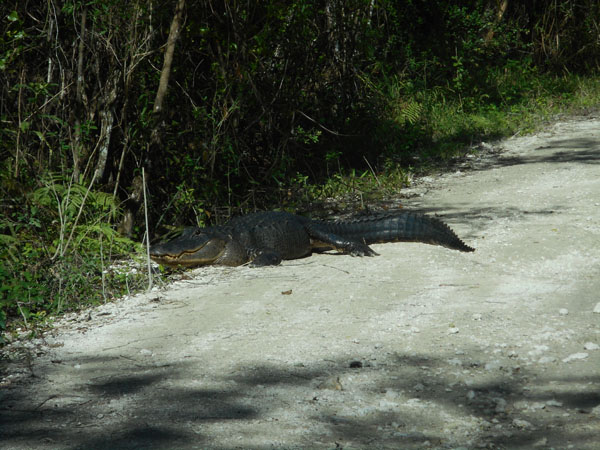 |
| Great egret |
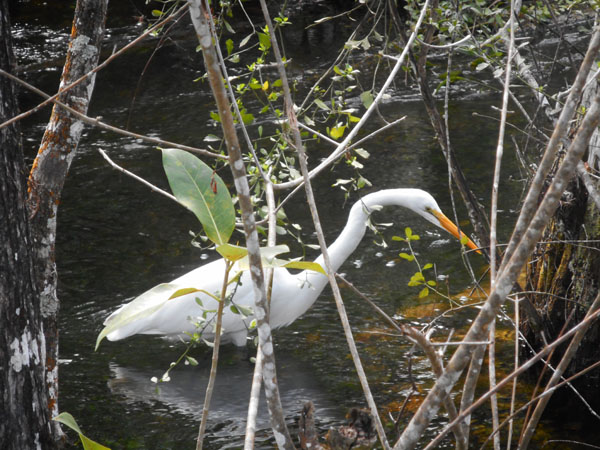 |
| Juvenile ibis |
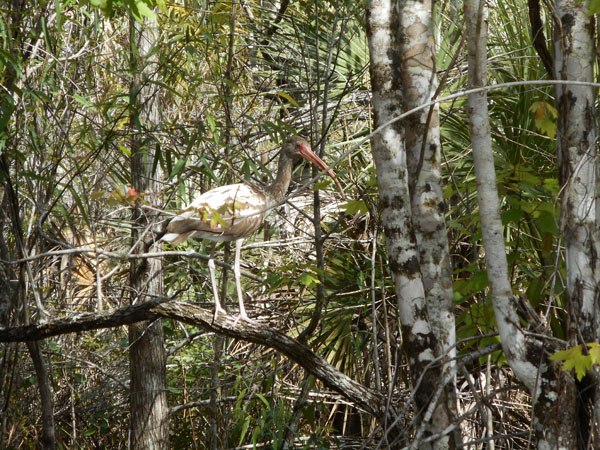 |
| Red-shouldered Hawk |
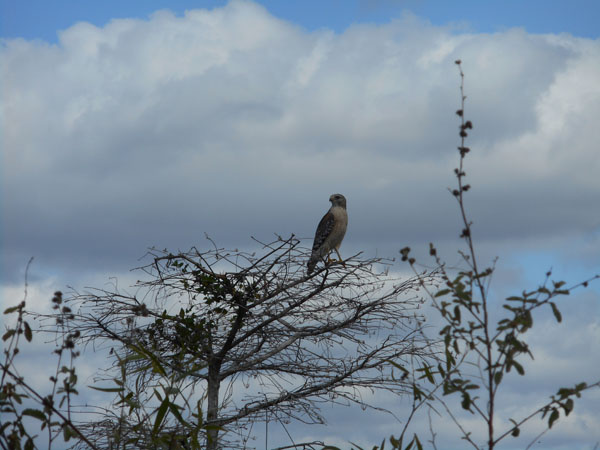 |
| little blue heron |
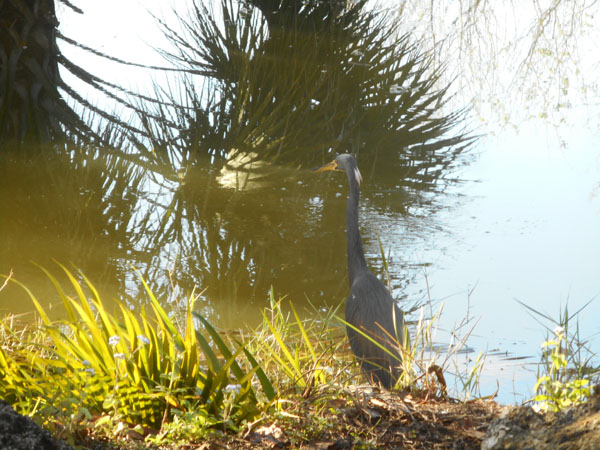 |
And the by-now-typical vulture conclave discussing "possum". ..with a video of them eating and gathering at breakfast |
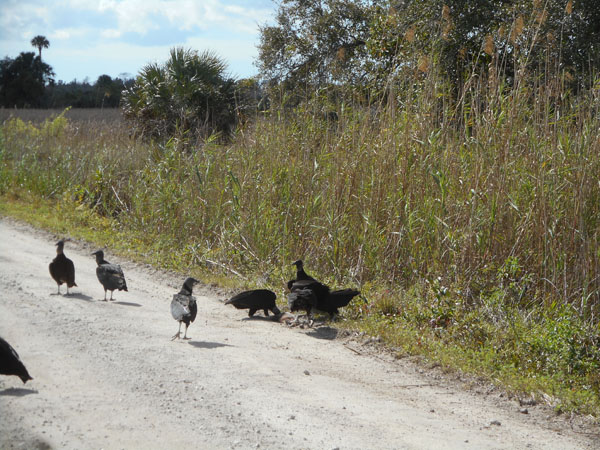 |
| We spent the afternoon touring the Naples art show and saying goodby to our friends who were heading back to Ohio after the show. |
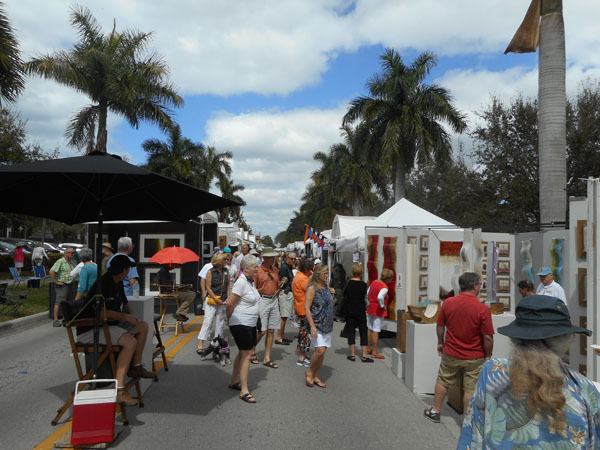 |
Dropping south from Naples, we visited Marco Island.
We paid for parking at the town's beach parking lot and hiked out a over a long and broad expanse of flat white sand to reach this, our last look at the Gulf side of Florida. |
 |
| and beach life, |
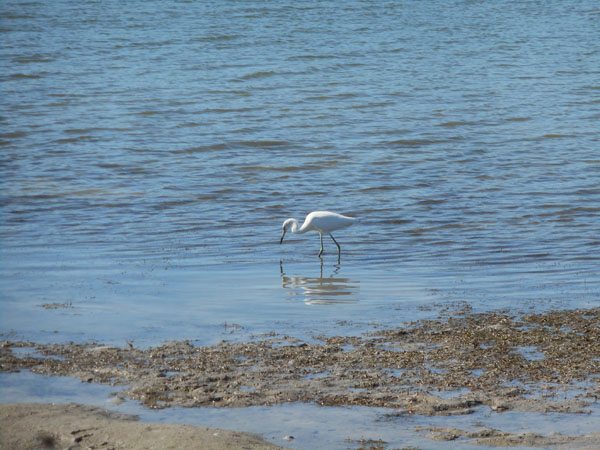 |
| diving pelicans, |
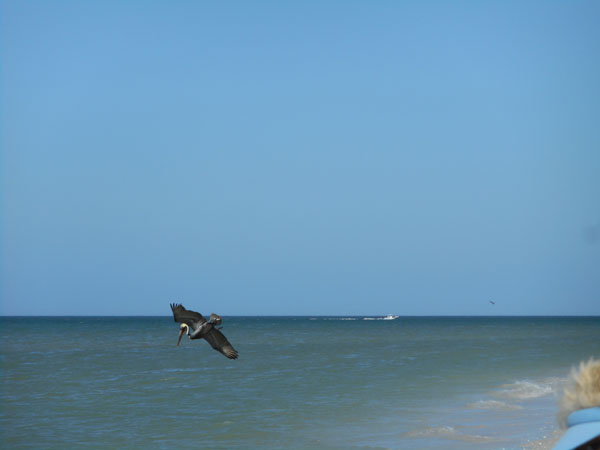 |
| |
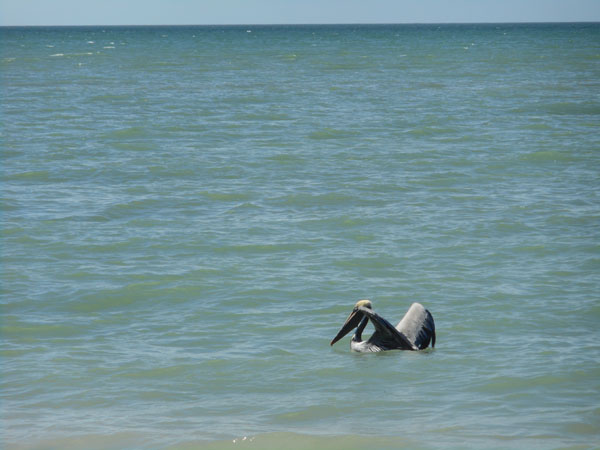 |
| White Ibis |
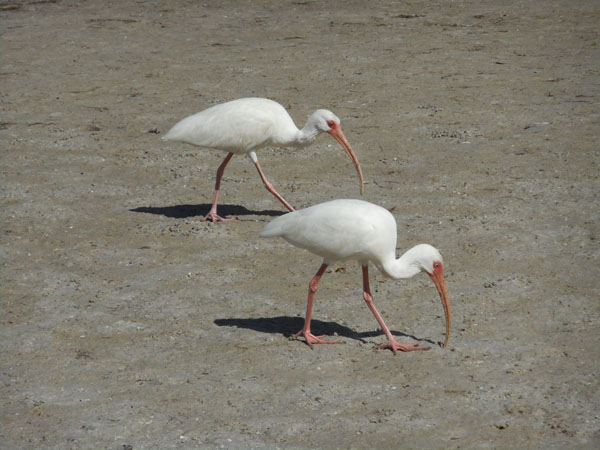 |
| and we too then headed out eastward. |
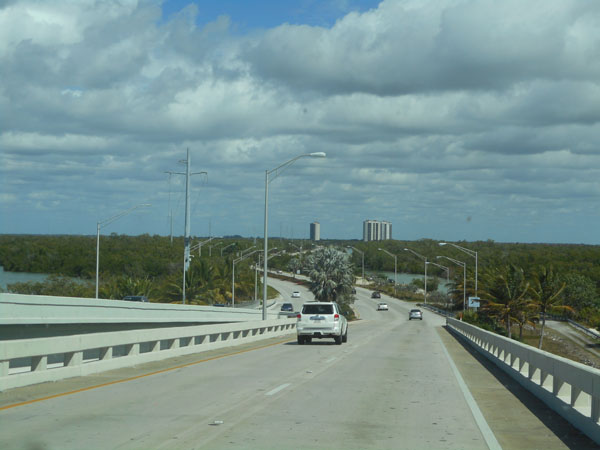 |
Stopping by the central Big Cypress visitor center to count gators again at their boardwalk (many more in the afternoon).
We asked if "so many" were typical... and were told that this was actually a fairly small crowd for a February. The unseasonable flooding of the entire area had spread out the wildlife instead of concentrating them in the ponds. |
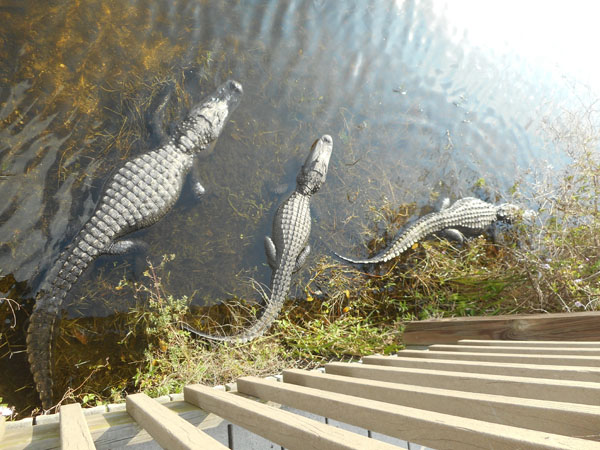 |
| Karen's favorite gator photo |
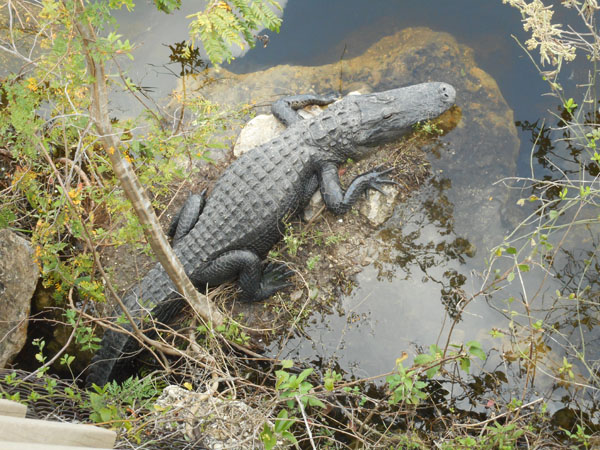 |
| watched by great blue heron |
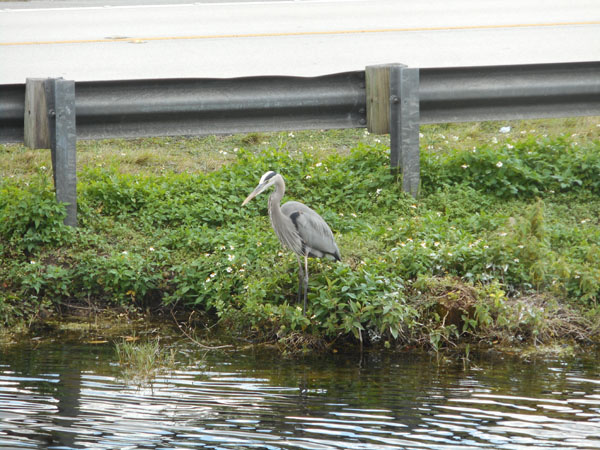 |
| The next day we got going early to catch the Shark Valley Tram's first run. Much of the tram road was about a foot underwater. |
 |
| Sawgrass prarie with both willow hammocks (wetter) and hardwood hammocks (drier) |
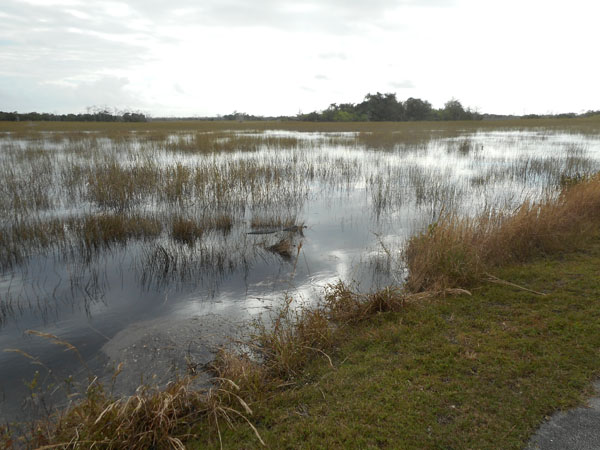 |
| and a bit of bald cypress |
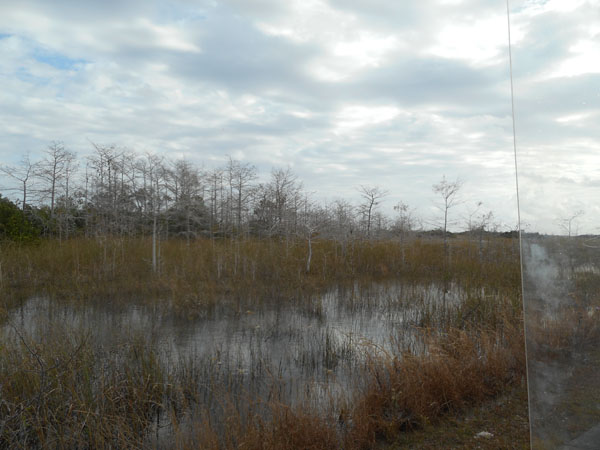 |
The usual bird life: great egrets (also snowy egrets) |
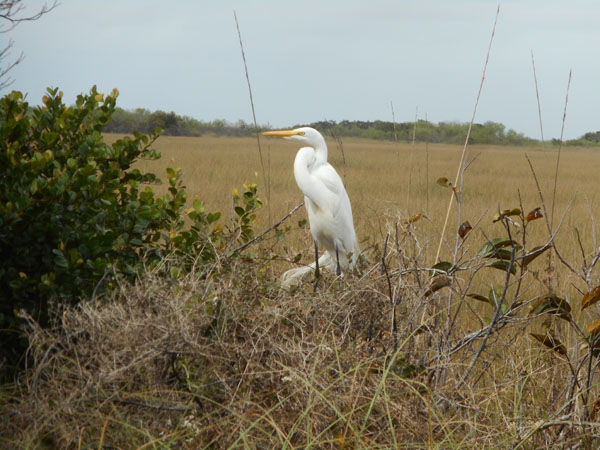 |
| great blue herons |
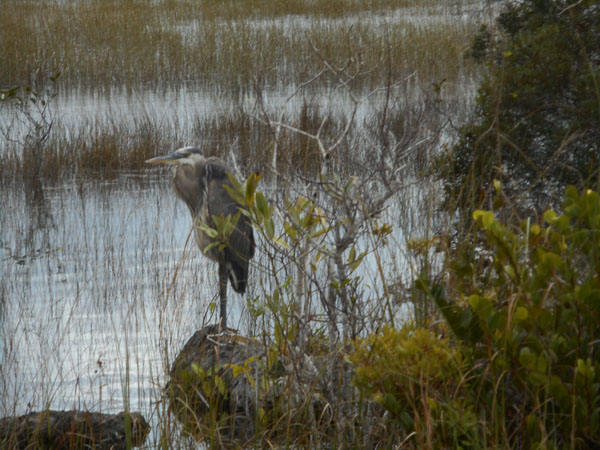 |
| little blue herons (also tricolored herons) |
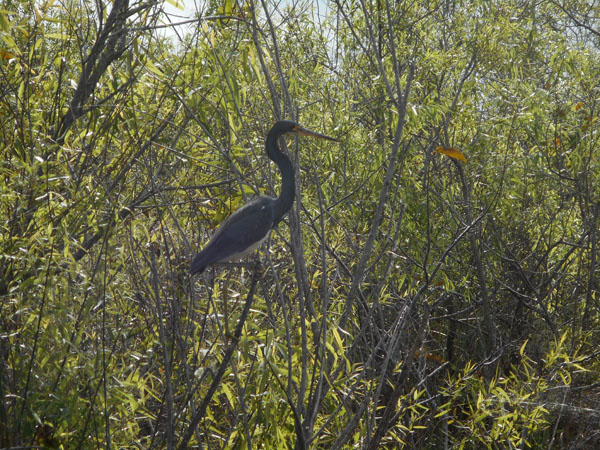 |
| Seven miles later, the tram's destination is an observation tower ... |
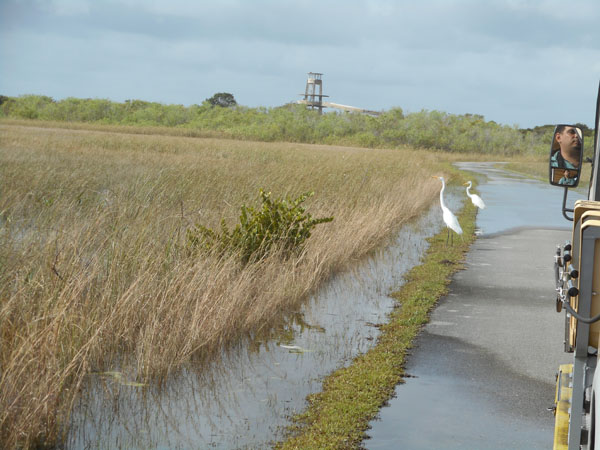 |
| with a good view over the flat land |
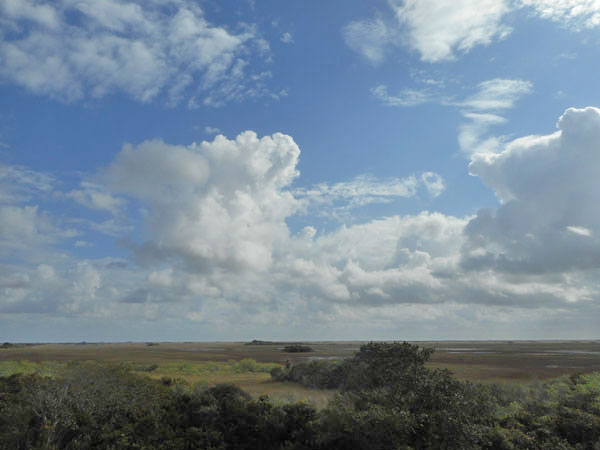 |
| The (flooded) road to the tower wandered through curves to visit various environments. The (also flooded) road back was dead-straight. |
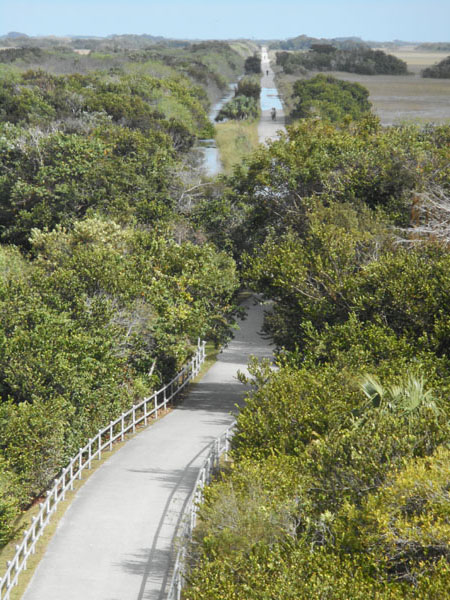 |
| We stopped for lunch at the only local option. By avoiding the pictured choices, lunch wasn't as bad as we feared it might be. Dick experimented with a Cuban Sandwich (at an Indian Village?) and Karen had a chicken caesar salad (yet again). |
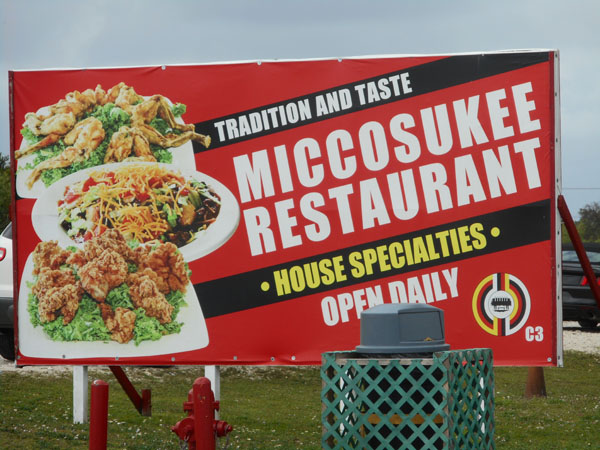 |
| The afternoon was spent revisiting the Kirby Storter Boardwalk. |
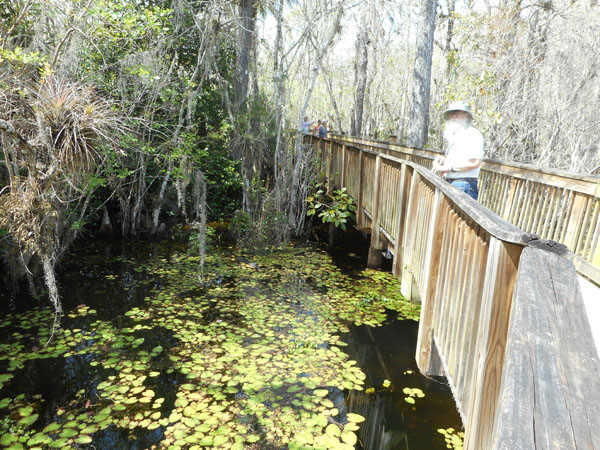 |
| ...with attendant big alligator. |
 |
| |
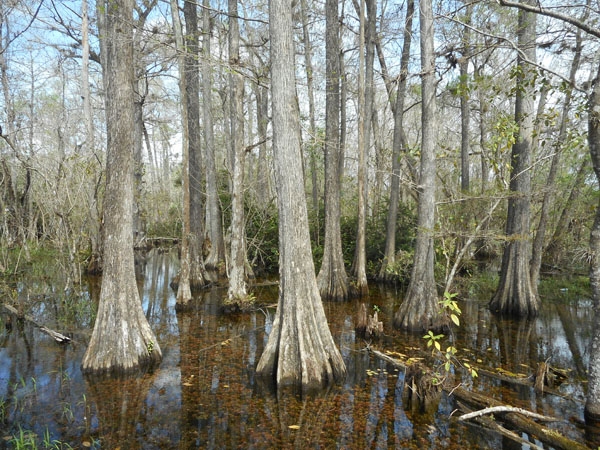 |
| |
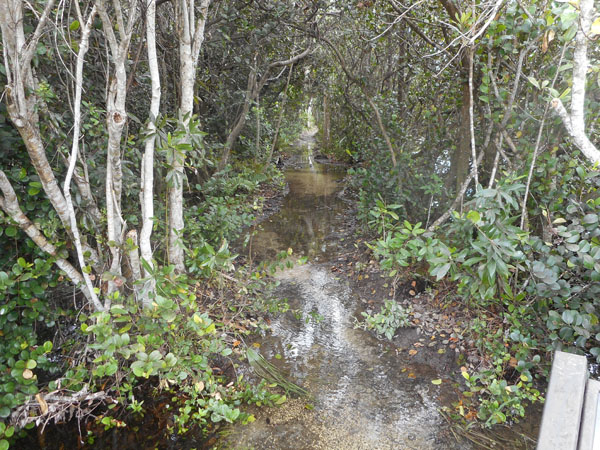 |
| On the way out we finally saw a middle sized gator, about 3 feet long: note yellow striping on tail. Probably about 3 years old as this is the age they start leaving their mothers. Of the 40 or so eggs to hatch from a nest, only an average of two hatchings make it to adulthood. The others feed the various birds, pythons, opossoms, racoons and other gators. |
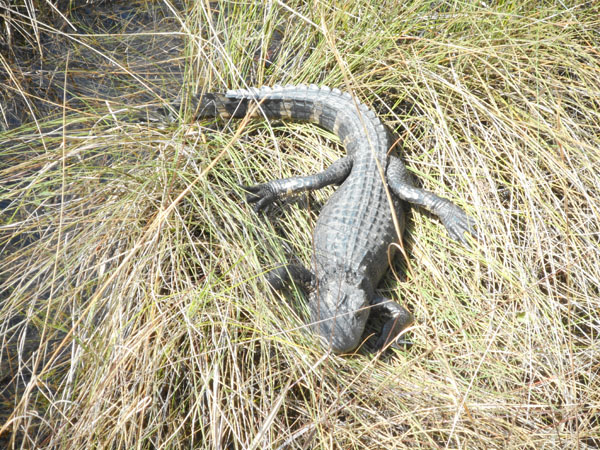 |
| And as roadkill they feed the vultures |
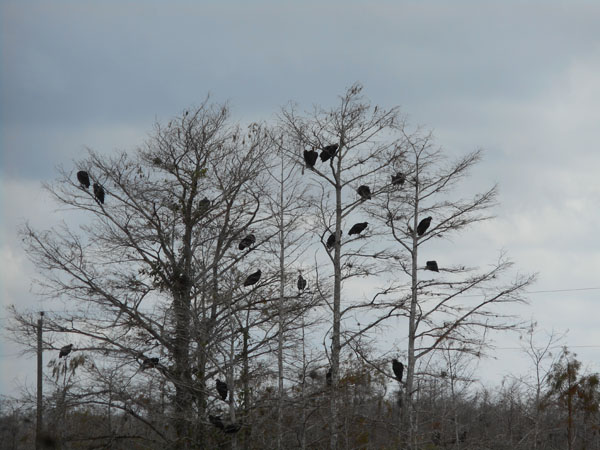 |
| We watched this heron fishing just feet from the traffic and then went back to Midway Campground to pack. |
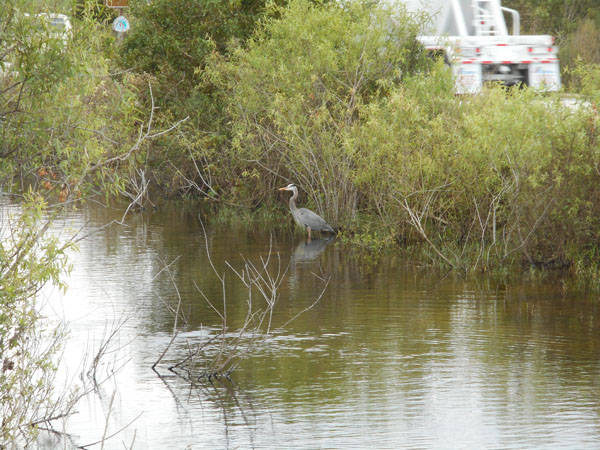 |
| After the slow pace of the everglades Miami the next morning was a shock |
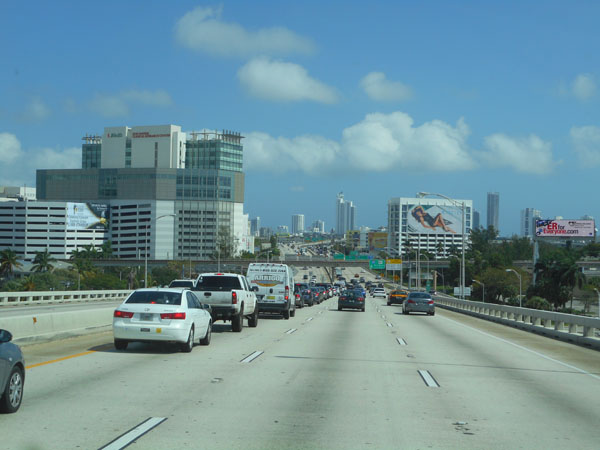 |
| Cruise ships line up along the causeway between Miami and Miami Beach. |
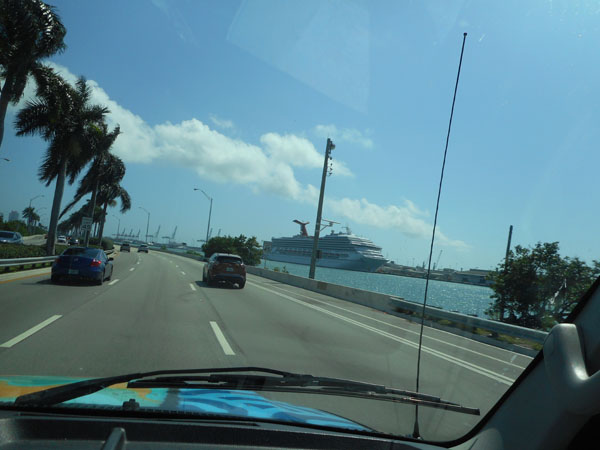 |
| and an unexpected red (motorized) galleon. |
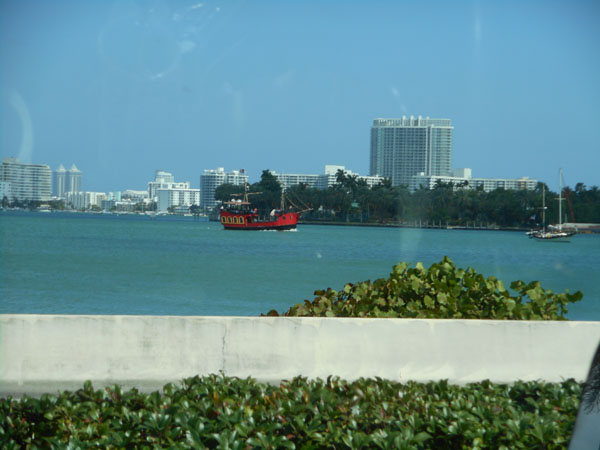 |
| Marinas packed with boats, yachts and mega-yachts. |
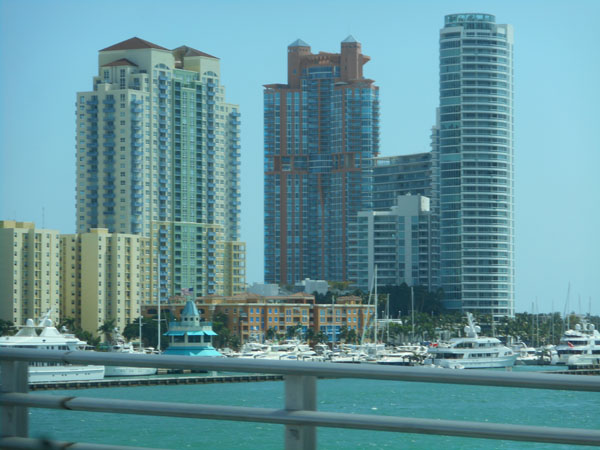 |
| We dropped off Quilt at the Escape Camper Van office, five blocks from our hotel. Walking back to the hotel we pondered the reality of living where the trees drop things like this on the sidewalk. Plus coconuts. |
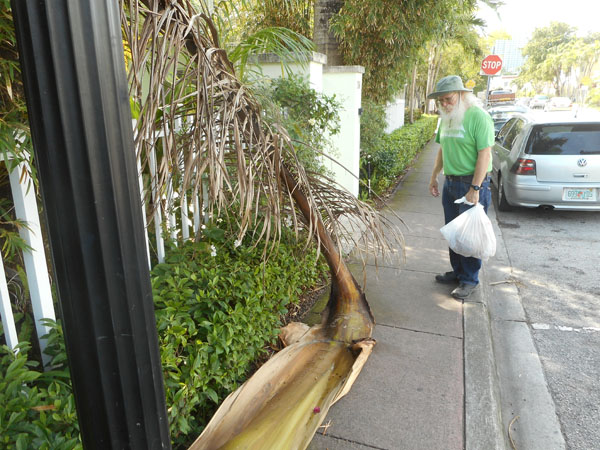 |
| All Miami Beach hotels charge a "resort fee". It pays for chairs, umbrellas and life guards on the beach. The chairs and umbrellas were being packed up due to end of the day and oncoming storm |
 |
| The lifeguard stations fly warning flags: one for weather, the other for swimming hazards. The purple swimmer's warning flags were out due to Portugese Man-O-War jellyfish (like this one blown ashore). |
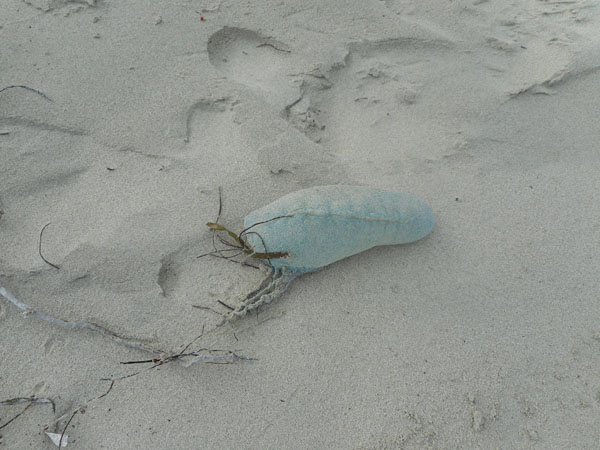 |
| The gulls and pelicans were playing with the wind |
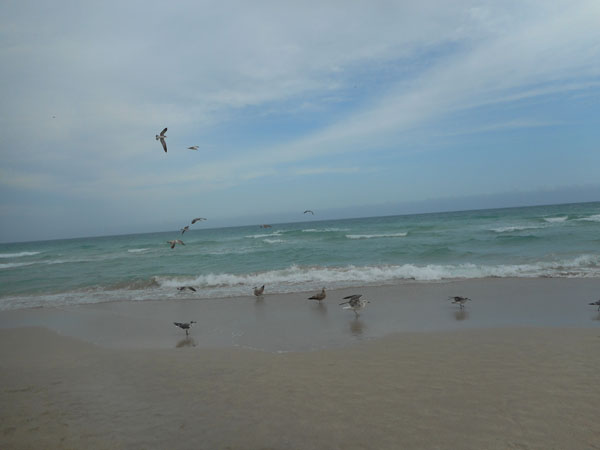 |
| the black skimmers were hunkered down |
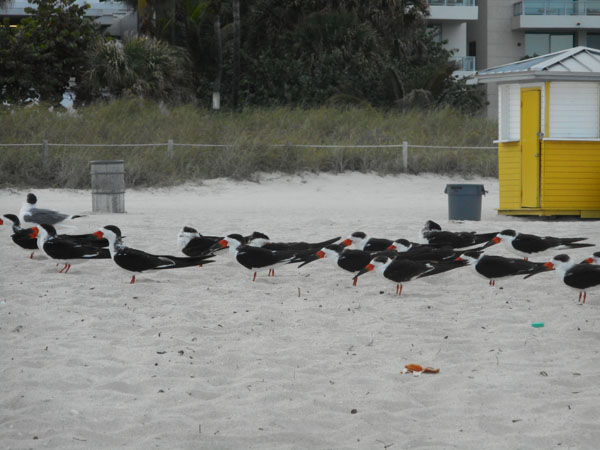 |
| The beach got buttoned up |
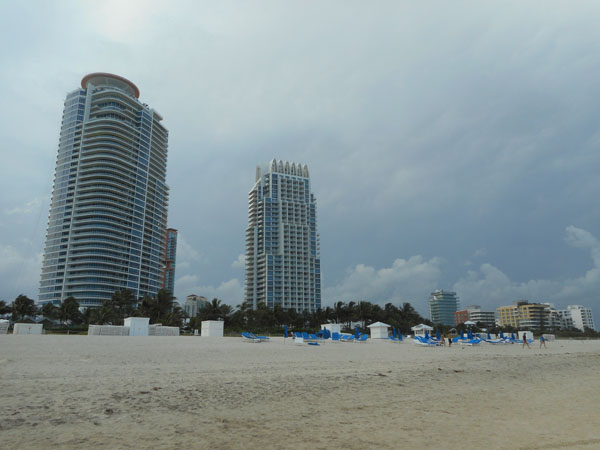 |
| But the touists were still playing in the sand and taking pictures |
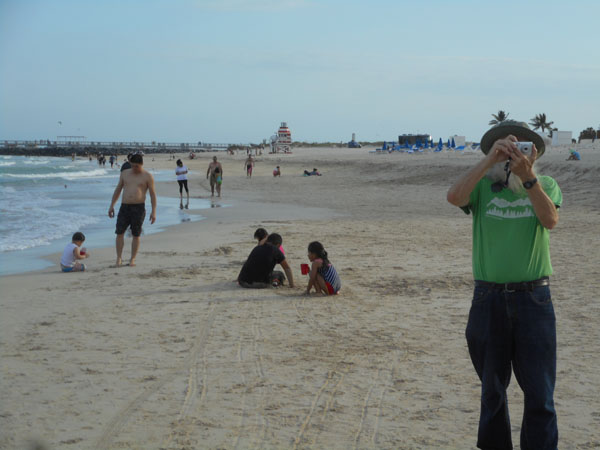 |
| |
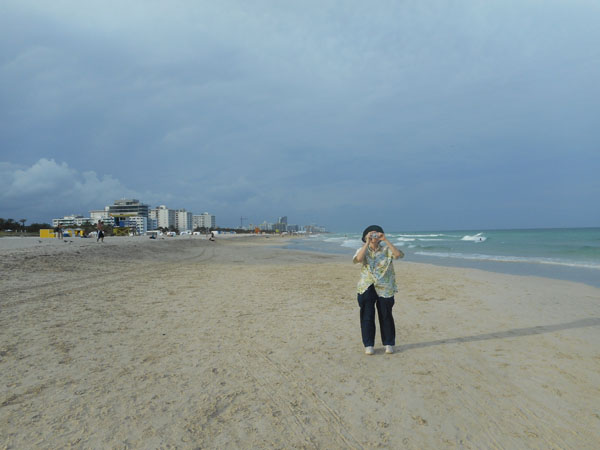 |
| We kept our eye on the approaching storm |
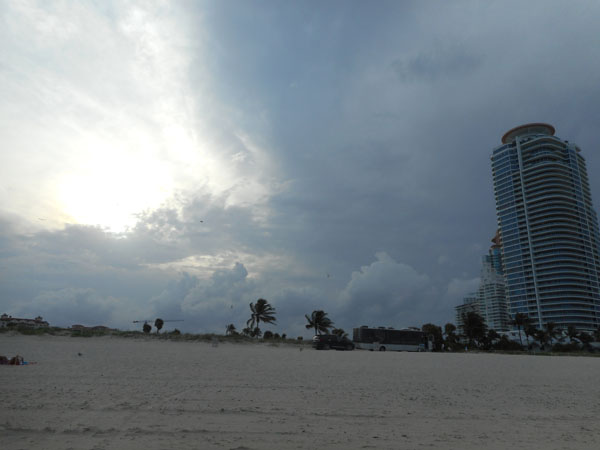 |
| We hiked down the beach to the south end of South Miami Beach, |
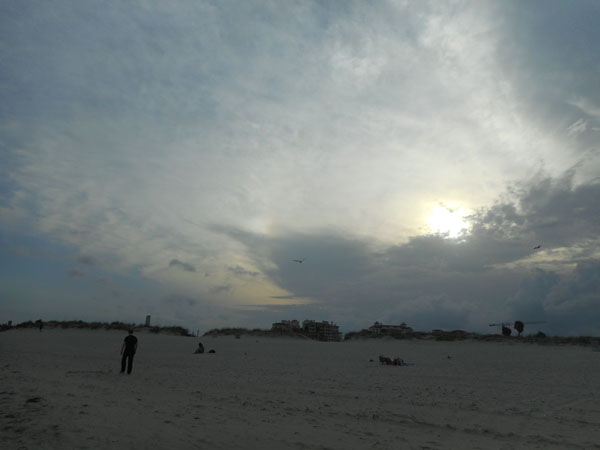 |
| ...then rounded the tip and headed back to the hotel before it started to rain ("Rain starts in 25 minutes" said our smartphone's MinuteCast). |
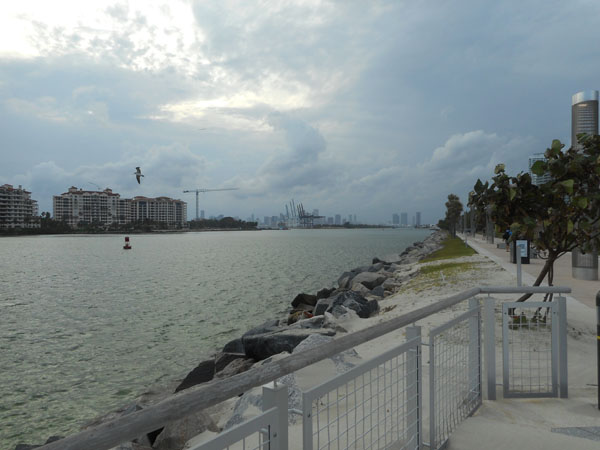 |
| The Clay Hotel is located in South Beach's Art Deco district which features lots of buildings like this. |
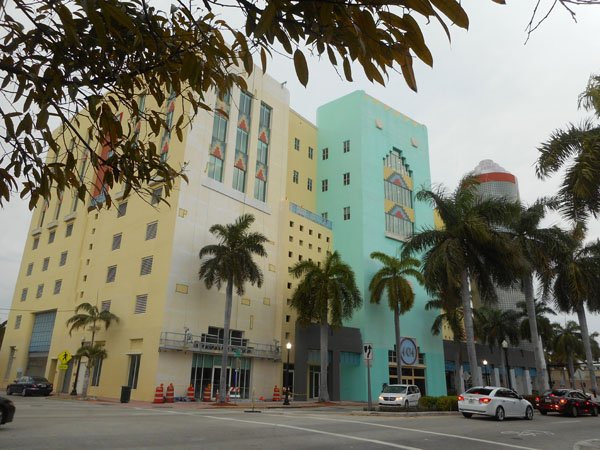 |
One side of our hotel fronted the pedestrian-only Espanola Way. The storefront restaurants spill tables out onto the pavement.
This time our room was just above a noisy nightclub so we didn't sleep as well as when we were on the rear of the 3rd floor (we recommend the Clay, just ask for a quiet room if you go to bed early). |
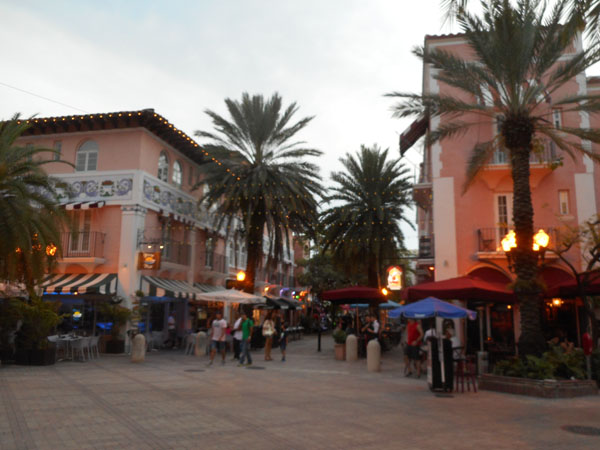 |
| The next morning we explored the tiny (2.5 acres), free Miami Botanical Gardens, a few blocks north of the Clay. |
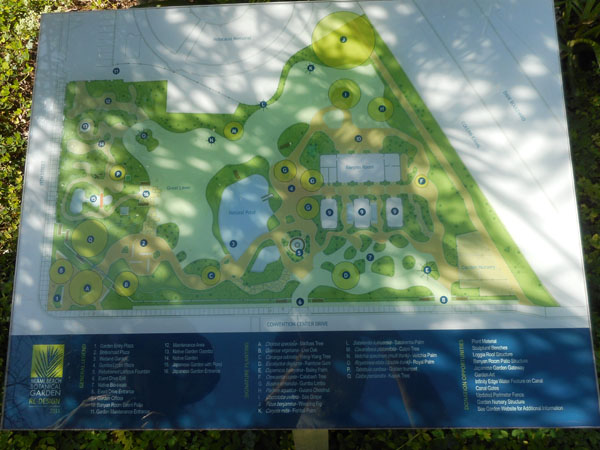 |
| A nice retreat from the local frenzy |
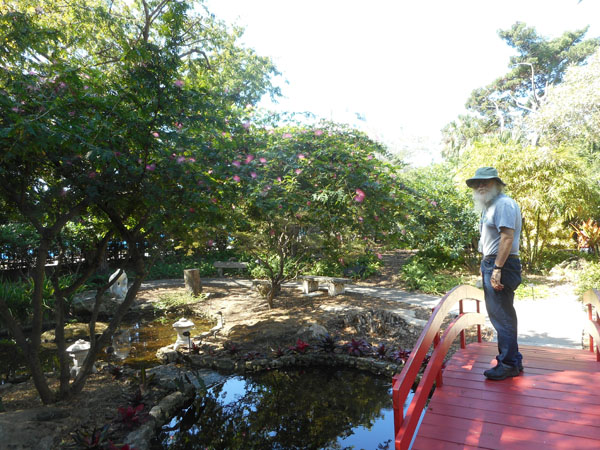 |
| |
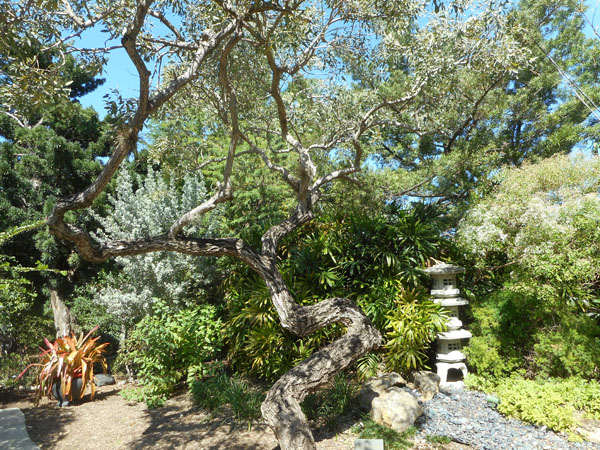 |
| |
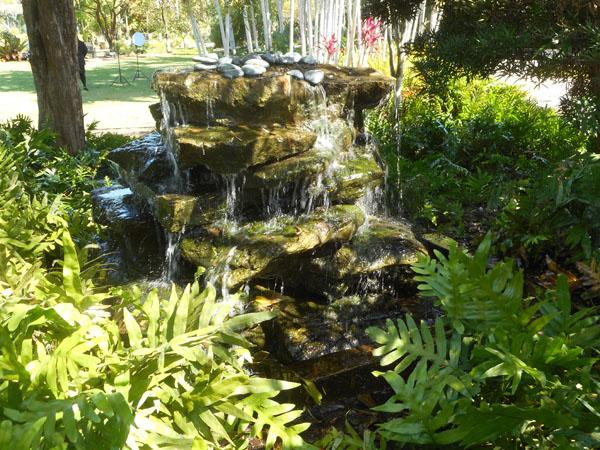 |
| |
 |
| With hot blossoms for the finale |
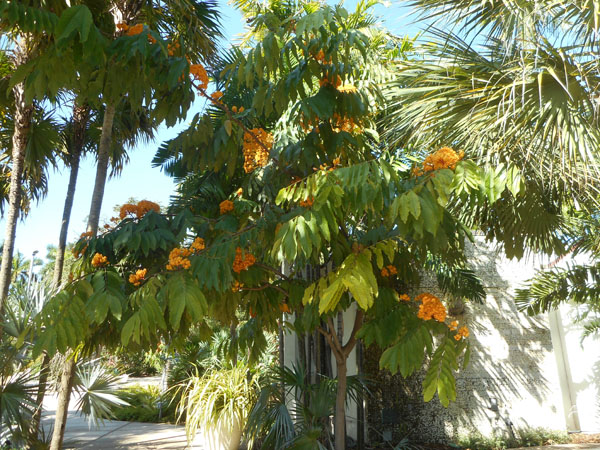 |
| Walking back toward the hotel we noticed this sculptural display of vegetation and pools in the middle of pedestrian-only Lincoln Road. The sign on the pools says "Clorinated water. May bleach clothes." It seems to work: no one was wading in them. |
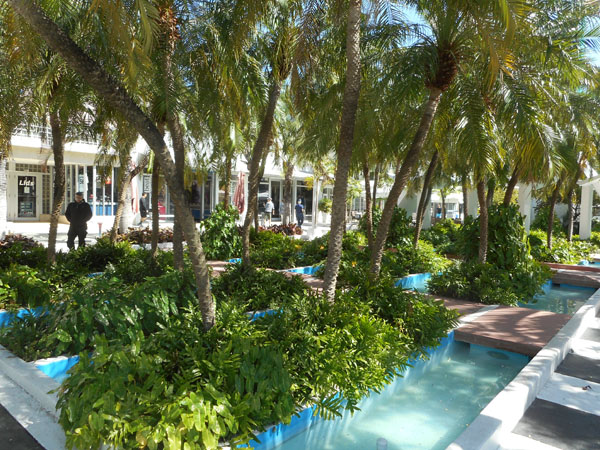 |
| We saw this a fun bit of art on an outdoor bar |
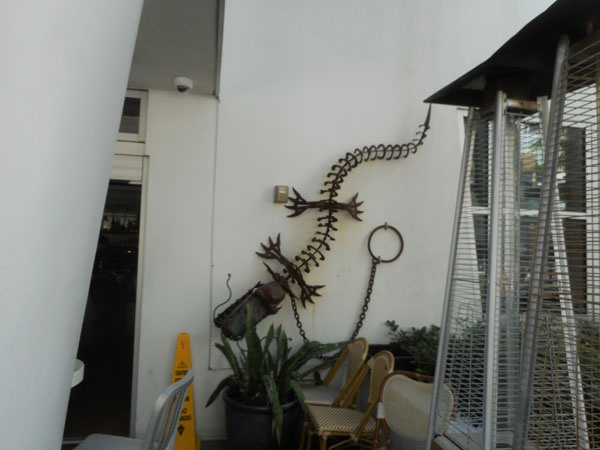 |
| and a colorful outdoor ride |
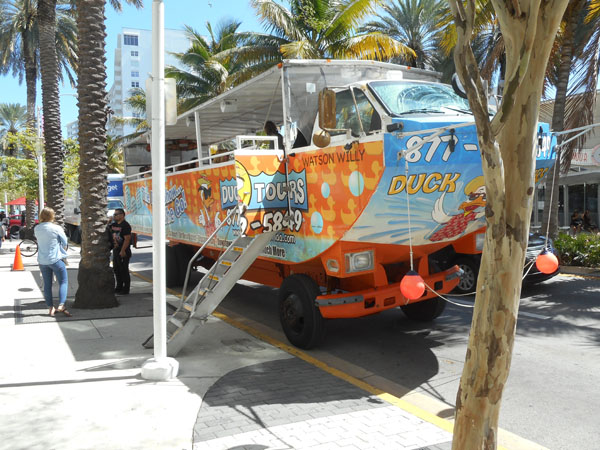 |
| Karen wished she could send some of these frond prunings to Jeremy to make bowls from but we had to leave in an hour. |
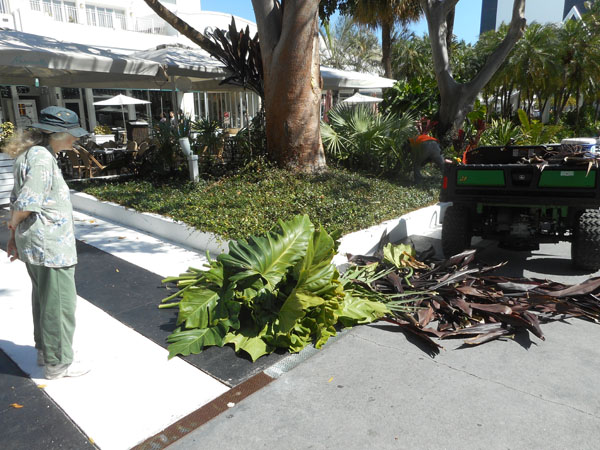 |
| Waiting in front of the hotel (with friend) for the shuttle to the airport. |
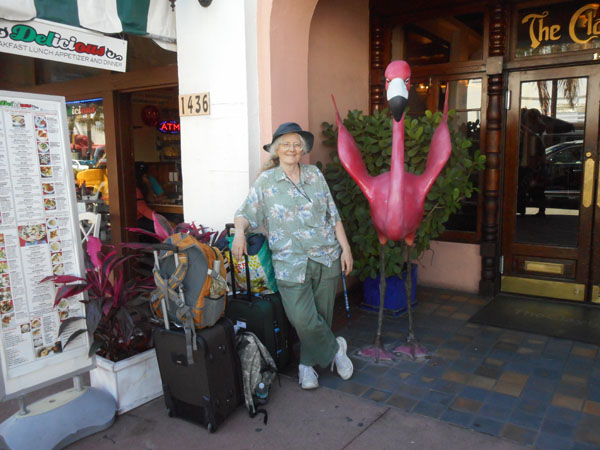 |
| The dark space under the wing isn't the ocean, it's the Everglades |
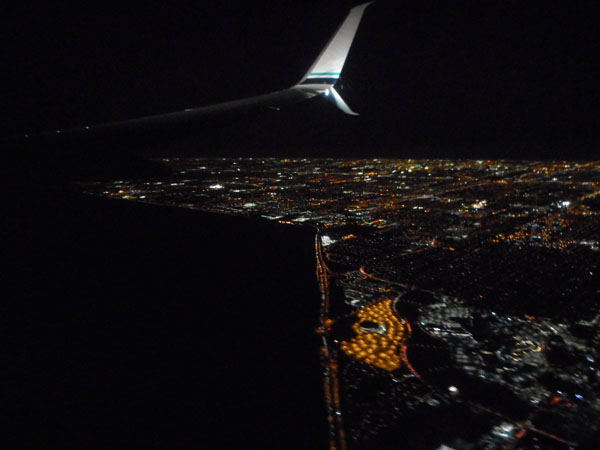 |













































































































































































